@
你逢人就炫耀的玫瑰,枯萎时该如何收场 我炫耀过的玫瑰永远都不会枯萎 可能有一天它选择了更好的土壤 但仍然会在我这里留下芳香 当我炫耀它的时候 就没想过束缚它 它开的更美,更艳才是我的初衷复制
Spring IOC 是软件组件松耦合度,而AOP让你能够捕捉系统中经常使用的功能,把它转化为组件。
AOP(Aspect Oriented Programming):面向切面编程 ,面向方面编程 。(AOP是一种编程技术)
AOP 是对OOP的补充延申。
AOP底层使用的就是动态代理,关于动态代理,想要了解更多的,大家可以移步至:✏️✏️✏️ GoF之代理模式(静态代理+动态代理(JDK动态代理+CGLIB动态代理带有一步一步详细步骤))-CSDN博客
Spring 的AOP使用的是动态代理是: JDK动态代理 + CGLIB 动态代理技术 。Spring 在这两种动态代理中灵活切换,如果是代理接口,会默认使用JDK动态代理,如果要代理某个类,这个类没有实现接口,就会切换使用CGLIB。当然,你也可以强制通过一些配置让Spring 只使用 CGLIB。(让文章内容有所说明)
一般一个系统当中都会有一些系统服务,例如:日志,事务处理,安全等,这些系统服务被称为:交叉业务 。这些交叉业务 几乎是通用的,不管你是做银行账户转账,还是删除用户数据。日志,事务处理,安全,这些都是需要做的。
如果在每一个业务处理过程当中,都参杂这些交叉业务 代码进去的话,存在两方面的问题:
- 第一:交叉业务代码在多个业务流程中反复出现,显然这个交叉业务 代码并没有得到充分的复用,并且修改这些交叉业务 代码的话,需要修改多处。
- 第二:程序员无法专注核心业务代码的编写,在编写核心业务代码的同时还需要处理这些交叉业务。
使用 AOP 可以很轻松的解决以上问题。
如下图:可以更好的理解 AOP思想。
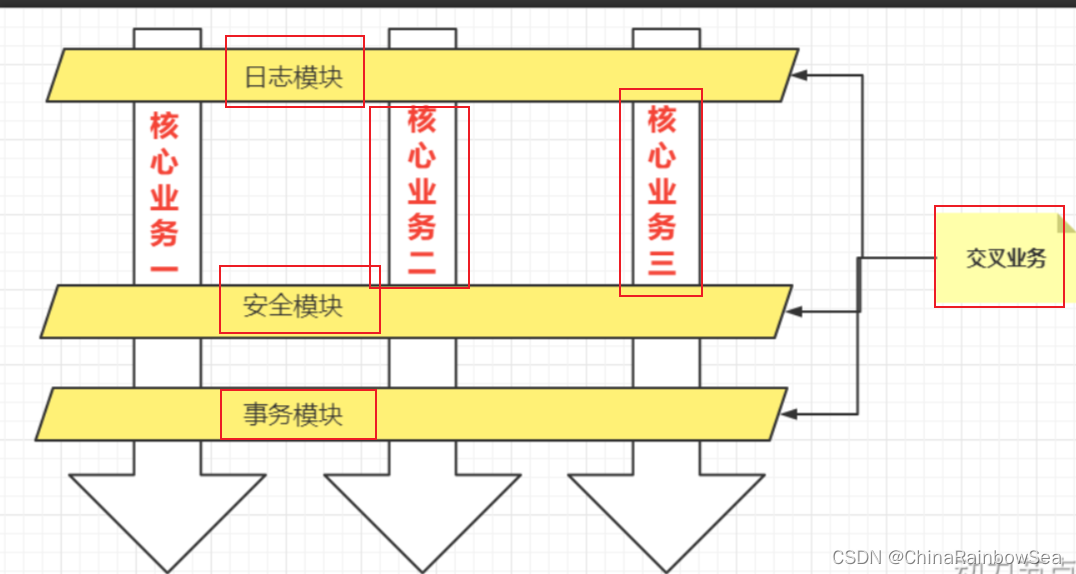
简单的说AOP:就是将与核心业务 无关的代码抽离开来,形成一个独立的组件,然后,以横向 交叉的方式应用到业务流程当中的过程被称为 AOP 。
AOP的优点:
- 代码的复用性增强
- 代码易维护
- 使开发者更关注业务逻辑
在程序的整个执行流程中,可以切入 的位置,方法的执行前后,异常抛出之后等位置。
在程序执行流程中,真正织入 切面的方法。(一个切点对应多个连接点)
通知叫增强,就是具体你要插入\添加 的代码。
通知包括:
- 前置通知
- 后置通知
- 环绕通知
- 异常通知
- 最终通知
把通知应用到目标对象的过程
一个目标对象被织入通知后产生的新对象
被织入通知的对象。
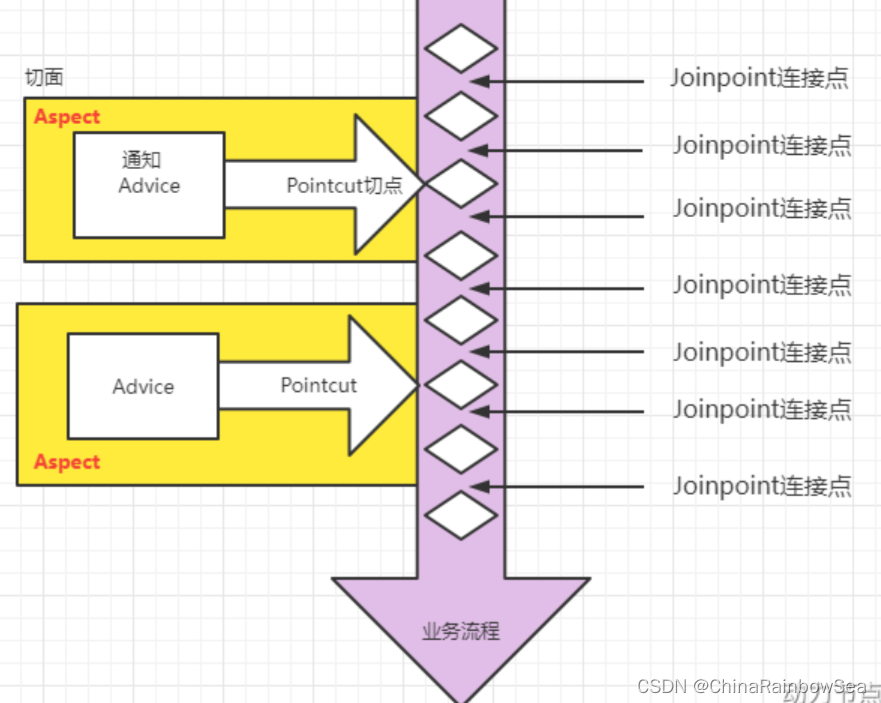
所谓的切点表达式:就是用来定义通知(Advice) 往哪些方法上切入的。
切入点表达式语法表达格式:
execution([访问控制权限修饰符] 返回值类型 [全限定类名]方法名(形式参数列表) [异常])复制
访问控制权限修饰符:
可选项,可以没有 没写,就是默认包括了4个权限 写public 就表示只包括公开的方法。复制
- 返回值类型:
必须要有 “*” 表示返回值类型任意复制
- 全限定类名
可选项:可以不写 “..” 两个点,表示当前包以及子包下的所有类 省略:表示包括所有的类;就是所有复制
- 方法名
必填项 "*" 表示该对应包下的所有任意方法() 就是所有的方法 set* 则表示所有 set 开头的方法() get* 则表示所有 get 开头的方法()复制
- 形式参数列表
必填项 () 空括号,表示没有参数的方法。 (..) 括号中有两个点,表示参数类型和参数个数任意的方法, (*) 表示只有一个参数的方法 (*,String) 第一个参数类型随意,第二个参数类型必须是String 类型才行复制
- 异常:
可选项 省略表示任意异常类型复制
举例:
execution(public * com.rainbowsea.mall.service.*.delete*(..))
// 表示 public 公开的, * 返回值随意,在 com.rainbowsea.mall.service.* 包下以及子包下的类, delete开头的方法名的方法(参数随意(个数任意,参数类型任意)),的方法。
复制
execution(* com.rainbowsea.mall..*(..))
// 表示 权限符(省略,则默认是包含了4种权限了), * 返回值随意,com.rainbowsea.mall 包下以及子包下的 ..* 任意类,任意方法名,方法中的参数(个数任意,参数类型任意)
复制
execution(* *(..))
// 表示所有的类当中的所有方法,就是所有
复制
Spring 对AOP 的实现包括以下 三种方式:
- 第一种方式:Spring 框架结合 AspectJ框架实现的AOP,基于注解方式(该比较常用)。
- 第二种方式:Spring框架结合AspectJ框架实现的AOP,基于XML方式。
- 第三种方式:Spring 框架自己实现的AOP,基于XML方式。(并不怎么用)
实际开发中,都是Spring + AspectJ实现AOP。所以我们重点学习使用第一种和第二种方式。
什么是AspectJ ? (Eclipse组织的一个支持AOP的框架。AspectJ框架是独立于Spring框架之外的一个框架,Spring框架用了AspectJ)
AspectJ项目起源于帕洛阿尔托(Palo Alto)研究中心(缩写为PARC)。该中心由Xerox集团资助,Gregor Kiczales领导,从1997年开始致力于AspectJ的开发,1998年第一次发布给外部用户,2001年发布1.0 release。为了推动AspectJ技术和社团的发展,PARC在2003年3月正式将AspectJ项目移交给了Eclipse组织,因为AspectJ的发展和受关注程度大大超出了PARC的预期,他们已经无力继续维持它的发展。
使用Spring+AspectJ的AOP需要引入的依赖如下:
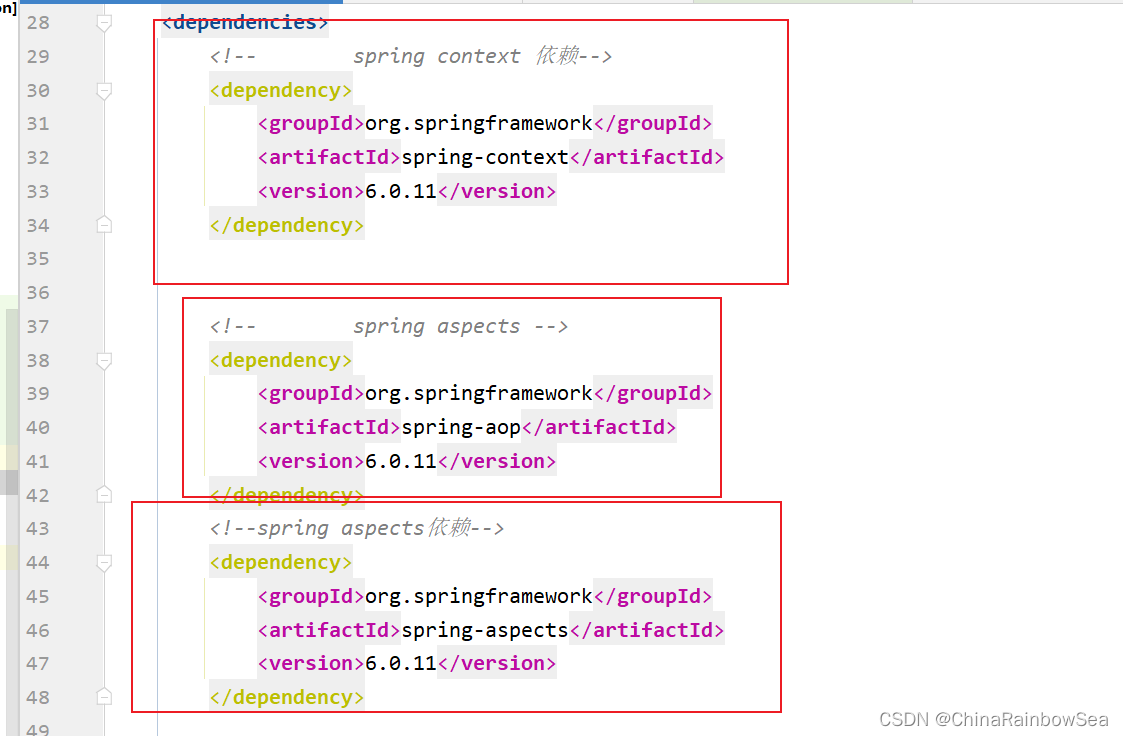
<!-- Spring 的仓库-->
<repositories>
<repository>
<id>repository.spring.milestone</id>
<name>Spring Milestone Repository</name>
<url>https://repo.spring.io/milestone</url>
</repository>
</repositories>
<dependencies>
<!-- spring context 依赖-->
<dependency>
<groupId>org.springframework</groupId>
<artifactId>spring-context</artifactId>
<version>6.0.11</version>
</dependency>
<!-- spring aspects -->
<dependency>
<groupId>org.springframework</groupId>
<artifactId>spring-aop</artifactId>
<version>6.0.11</version>
</dependency>
<!--spring aspects依赖-->
<dependency>
<groupId>org.springframework</groupId>
<artifactId>spring-aspects</artifactId>
<version>6.0.11</version>
</dependency>
复制这边,我多用上了一个 junit4 的注解
<?xml version="1.0" encoding="UTF-8"?>
<project xmlns="http://maven.apache.org/POM/4.0.0"
xmlns:xsi="http://www.w3.org/2001/XMLSchema-instance"
xsi:schemaLocation="http://maven.apache.org/POM/4.0.0 http://maven.apache.org/xsd/maven-4.0.0.xsd">
<modelVersion>4.0.0</modelVersion>
<groupId>com.rainbowsea</groupId>
<artifactId>spring6-012-aop-realapp</artifactId>
<version>1.0-SNAPSHOT</version>
<packaging>jar</packaging>
<properties>
<maven.compiler.source>17</maven.compiler.source>
<maven.compiler.target>17</maven.compiler.target>
</properties>
<!-- Spring 的仓库-->
<repositories>
<repository>
<id>repository.spring.milestone</id>
<name>Spring Milestone Repository</name>
<url>https://repo.spring.io/milestone</url>
</repository>
</repositories>
<dependencies>
<!-- spring context 依赖-->
<dependency>
<groupId>org.springframework</groupId>
<artifactId>spring-context</artifactId>
<version>6.0.11</version>
</dependency>
<!-- spring aspects -->
<dependency>
<groupId>org.springframework</groupId>
<artifactId>spring-aop</artifactId>
<version>6.0.11</version>
</dependency>
<!--spring aspects依赖-->
<dependency>
<groupId>org.springframework</groupId>
<artifactId>spring-aspects</artifactId>
<version>6.0.11</version>
</dependency>
<!-- junit4 -->
<dependency>
<groupId>junit</groupId>
<artifactId>junit</artifactId>
<version>4.13.2</version>
<scope>test</scope>
</dependency>
</dependencies>
</project>
复制同时需要给:Spring.xml 配置文件中添加 context 命名空间和 aop 命名空间:

<?xml version="1.0" encoding="UTF-8"?>
<beans xmlns="http://www.springframework.org/schema/beans"
xmlns:xsi="http://www.w3.org/2001/XMLSchema-instance"
xmlns:context="http://www.springframework.org/schema/context"
xmlns:aop="http://www.springframework.org/schema/aop"
xsi:schemaLocation="http://www.springframework.org/schema/beans http://www.springframework.org/schema/beans/spring-beans.xsd
http://www.springframework.org/schema/context http://www.springframework.org/schema/context/spring-context.xsd
http://www.springframework.org/schema/aop http://www.springframework.org/schema/aop/spring-aop.xsd">
</beans>
复制准备工作,搞定之后,我们就可以进行 Spring 基于 AspectJ的 AOP 注解式开发了。
第一步: 定义好目标类和目标方法。如下:
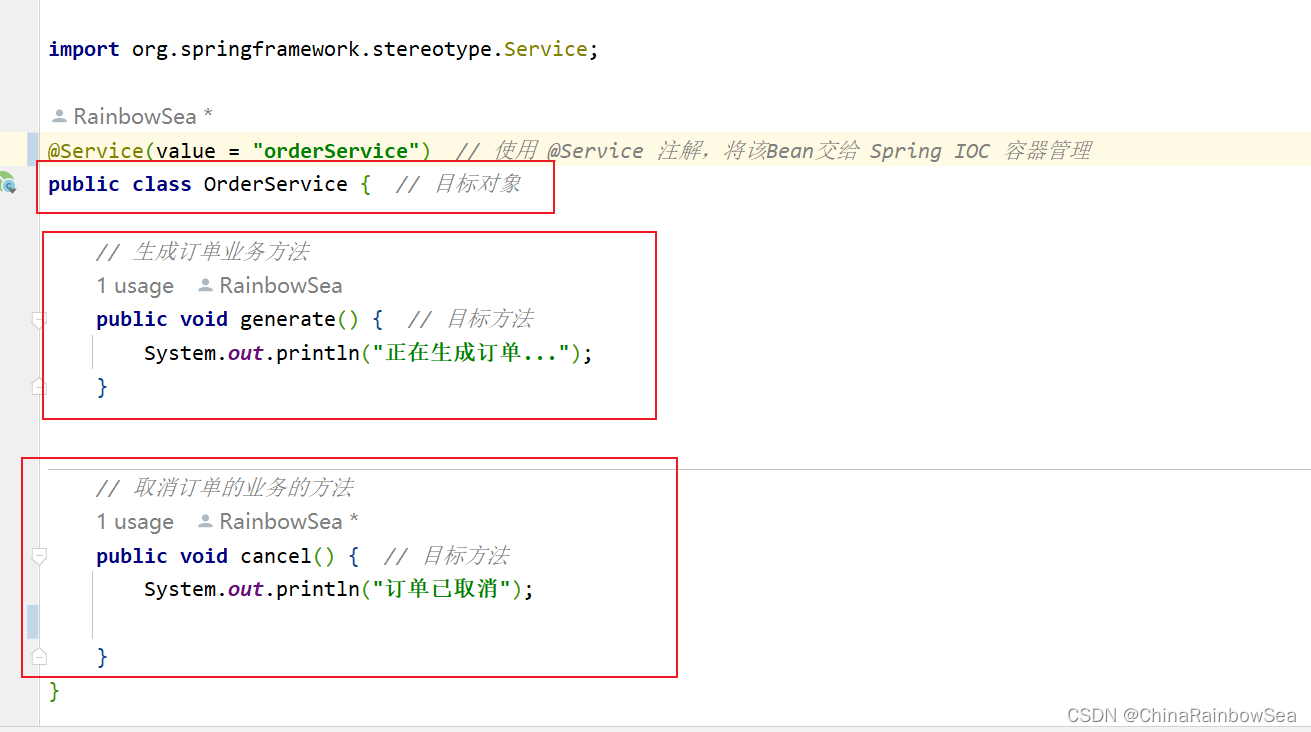
import org.springframework.stereotype.Service;
@Service(value = "orderService") // 使用 @Service 注解,将该Bean交给 Spring IOC 容器管理
public class OrderService { // 目标对象
// 生成订单业务方法
public void generate() { // 目标方法
System.out.println("正在生成订单...");
}
// 取消订单的业务的方法
public void cancel() { // 目标方法
System.out.println("订单已取消");
}
}
复制第二步: 定义切面类。
注意: 切面类也是要纳入Spirng IOC 容器当中管理的,因为你是在Spring 框架当中运用的AOP 编程,当然,需要被Spring 管理到,Spring 管理不到,又该让它如何使用呢。
目标类和切面类都纳入spring bean管理
在目标类OrderService上添加@Component 注解。
在切面类MyAspect类上添加@Component 注解。

package com.rainbowsea.spring6.service;
import org.springframework.stereotype.Component;
/**
* 切面类
*/
@Component(value = "myAspect") // 纳入 Spring IOC 容器当中管理
public class MyAspect {
}
复制第四步: 在spring配置文件中添加组建扫描
所谓的组件扫描:就是让我们里面的注解的位置,简单的说:就是让Spring 框架去哪些包下找,我们的注解,从而管理我们注解下的 Bean 类对象。
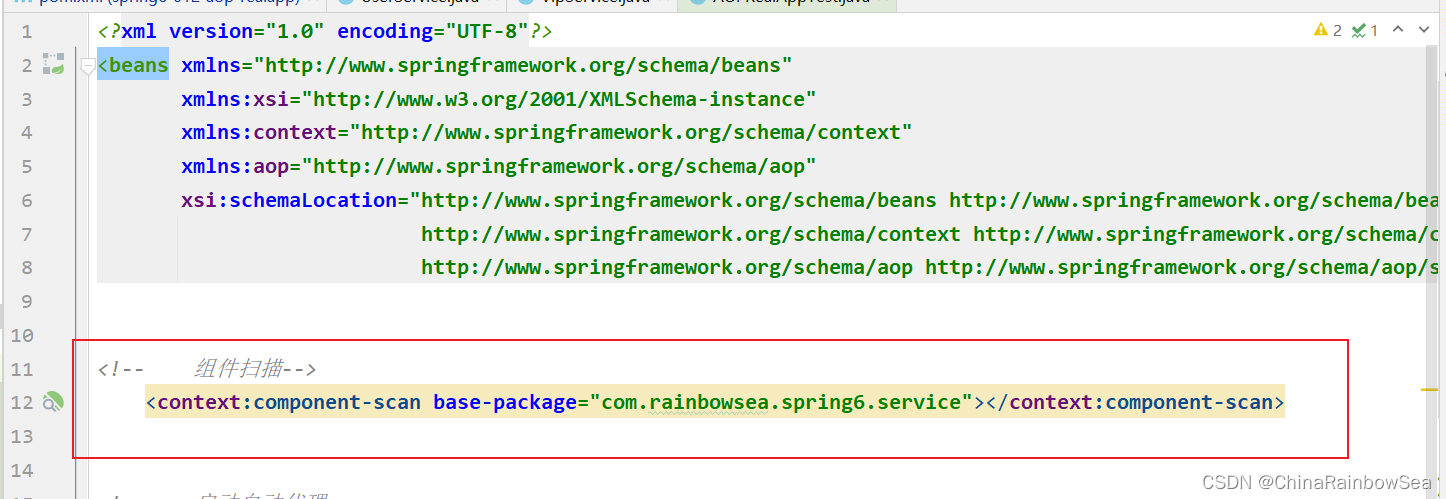
<?xml version="1.0" encoding="UTF-8"?>
<beans xmlns="http://www.springframework.org/schema/beans"
xmlns:xsi="http://www.w3.org/2001/XMLSchema-instance"
xmlns:context="http://www.springframework.org/schema/context"
xmlns:aop="http://www.springframework.org/schema/aop"
xsi:schemaLocation="http://www.springframework.org/schema/beans http://www.springframework.org/schema/beans/spring-beans.xsd
http://www.springframework.org/schema/context http://www.springframework.org/schema/context/spring-context.xsd
http://www.springframework.org/schema/aop http://www.springframework.org/schema/aop/spring-aop.xsd">
<!-- 组件扫描-->
<context:component-scan base-package="com.rainbowsea.spring6.service"></context:component-scan>
</beans>
复制第五步: 在切面类中添加通知
在切面类当中(对应的类当中)添加通知,就是将 @Aspect 注解,添加到类上就可以了,便会被Spring 框架开启事务通知的操作。
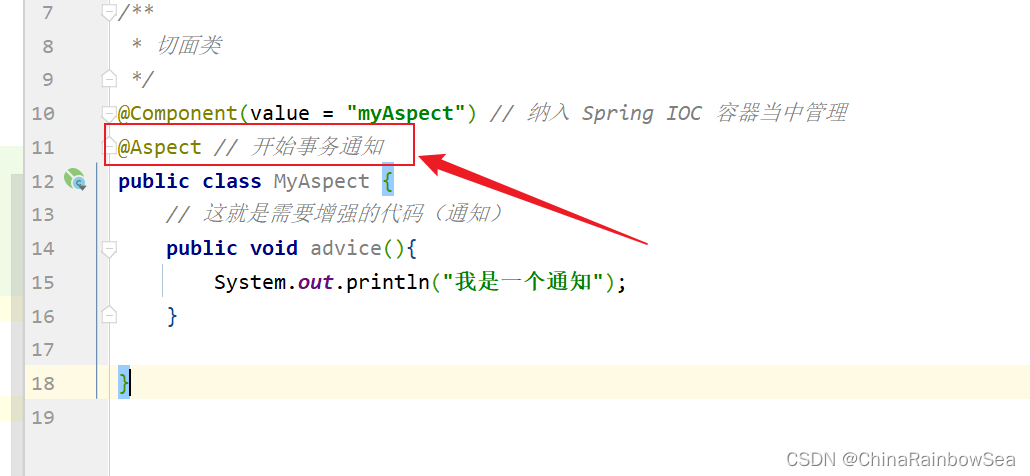
package com.rainbowsea.spring6.service;
import org.aspectj.lang.annotation.Aspect;
import org.springframework.stereotype.Component;
/**
* 切面类
*/
@Component(value = "myAspect") // 纳入 Spring IOC 容器当中管理
@Aspect // 开启事务通知
public class MyAspect {
// 这就是需要增强的代码(通知)
public void advice(){
System.out.println("我是一个通知");
}
}
复制第六步:在通知上添加切点表达式
在方法当中添加上
@Before()前置通知注解(详细内容,文章后面说明),想要使用该@Before() 注解的前提是,要在该切面类上添加上@Aspect开启事务的注解才行, @Before(execution编写切点表达式)。

package com.rainbowsea.spring6.service;
import org.aspectj.lang.annotation.Aspect;
import org.aspectj.lang.annotation.Before;
import org.springframework.stereotype.Component;
/**
* 切面类
*/
@Component(value = "myAspect") // 纳入 Spring IOC 容器当中管理
@Aspect // 开启事务通知
public class MyAspect {
// 这就是需要增强的代码(通知)
@Before("execution(* com.rainbowsea.spring6.service..*(..))") // 切面表达式:表示:权限符省略,任意返回值,该包下的以及包下的任意方法(参数类型,个人数任意)
public void advice(){
System.out.println("我是一个通知");
}
}
复制第七步: 在spring配置文件中启用自动代理

<?xml version="1.0" encoding="UTF-8"?>
<beans xmlns="http://www.springframework.org/schema/beans"
xmlns:xsi="http://www.w3.org/2001/XMLSchema-instance"
xmlns:context="http://www.springframework.org/schema/context"
xmlns:aop="http://www.springframework.org/schema/aop"
xsi:schemaLocation="http://www.springframework.org/schema/beans http://www.springframework.org/schema/beans/spring-beans.xsd
http://www.springframework.org/schema/context http://www.springframework.org/schema/context/spring-context.xsd
http://www.springframework.org/schema/aop http://www.springframework.org/schema/aop/spring-aop.xsd">
<!-- 组件扫描-->
<context:component-scan base-package="com.rainbowsea.spring6.service"></context:component-scan>
<!-- 启动自动代理-->
<aop:aspectj-autoproxy></aop:aspectj-autoproxy>
</beans>
复制<aop:aspectj-autoproxy proxy-target-class="true"/> 开启自动代理之后,凡事带有@Aspect注解的bean都会生成代理对象。
proxy-target-class="true" 表示采用cglib动态代理
proxy-target-class="false" 表示采用jdk动态代理。默认值是false。即使写成false,当没有接口的时候,也会自动选择cglib生成代理类。
复制第八步: 测试程序:
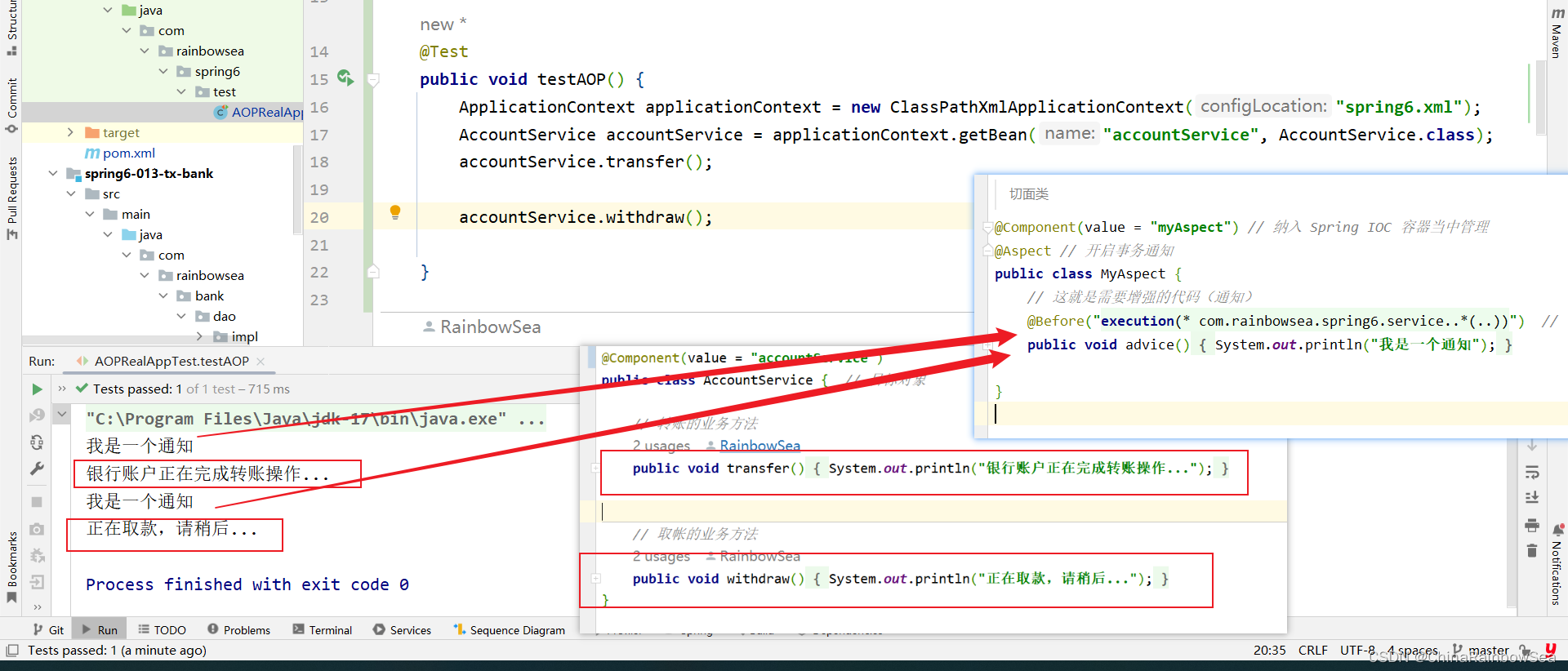
import com.rainbowsea.spring6.service.AccountService;
import com.rainbowsea.spring6.service.OrderService;
import com.rainbowsea.spring6.service.UserService;
import com.rainbowsea.spring6.service.VipService;
import org.junit.Test;
import org.springframework.context.ApplicationContext;
import org.springframework.context.support.ClassPathXmlApplicationContext;
public class AOPRealAppTest {
@Test
public void testAOP() {
ApplicationContext applicationContext = new ClassPathXmlApplicationContext("spring6.xml");
AccountService accountService = applicationContext.getBean("accountService", AccountService.class);
accountService.transfer();
accountService.withdraw();
}
}
复制在Spring 的 AOP当中:有如下五种通知类型:
- 前置通知:
@Before目标方法执行之前的通知- 后置通知:
@AfterReturning目标方法执行之后的通知- 环绕通知:
@Around目标方法之前添加通知,通知目标方法执行之后添加通知- 异常通知:
@AfterThrowing发生异常之后执行的通知- 最终通知:
@After放在 finally 语句块当中的通知注意:以上五种通知,可以配合上,同时使用上
注意:想要运用通知,需要在对应的切面类上(通知类)上,添加上
@Aspect注解,开启事务通知,才行 。
@Before 目标方法执行之前的通知前置通知使用: @Before(切面表达式)
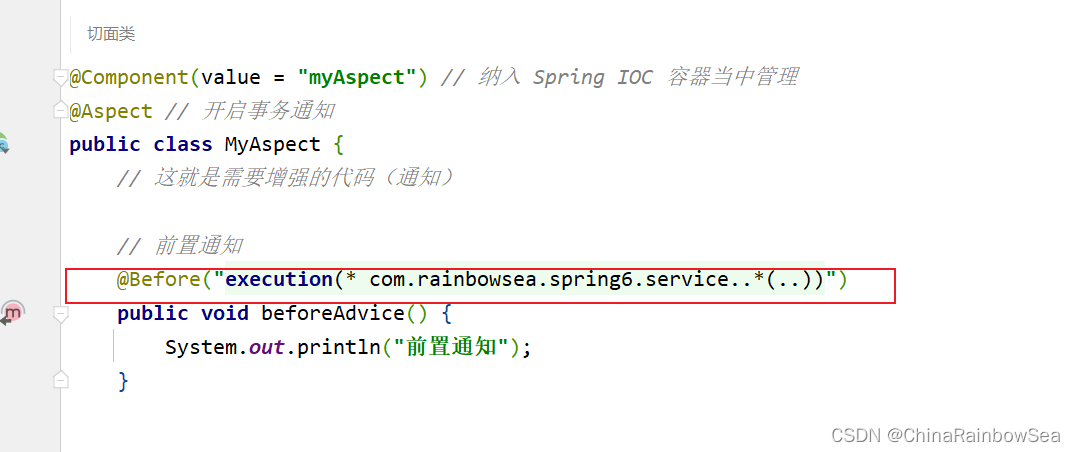
import org.aspectj.lang.annotation.Around;
import org.aspectj.lang.annotation.Aspect;
import org.aspectj.lang.annotation.Before;
import org.springframework.stereotype.Component;
/**
* 切面类
*/
@Component(value = "myAspect") // 纳入 Spring IOC 容器当中管理
@Aspect // 开启事务通知
public class MyAspect {
// 这就是需要增强的代码(通知)
// 前置通知
@Before("execution(* com.rainbowsea.spring6.service..*(..))")
public void beforeAdvice() {
System.out.println("前置通知");
}
}
复制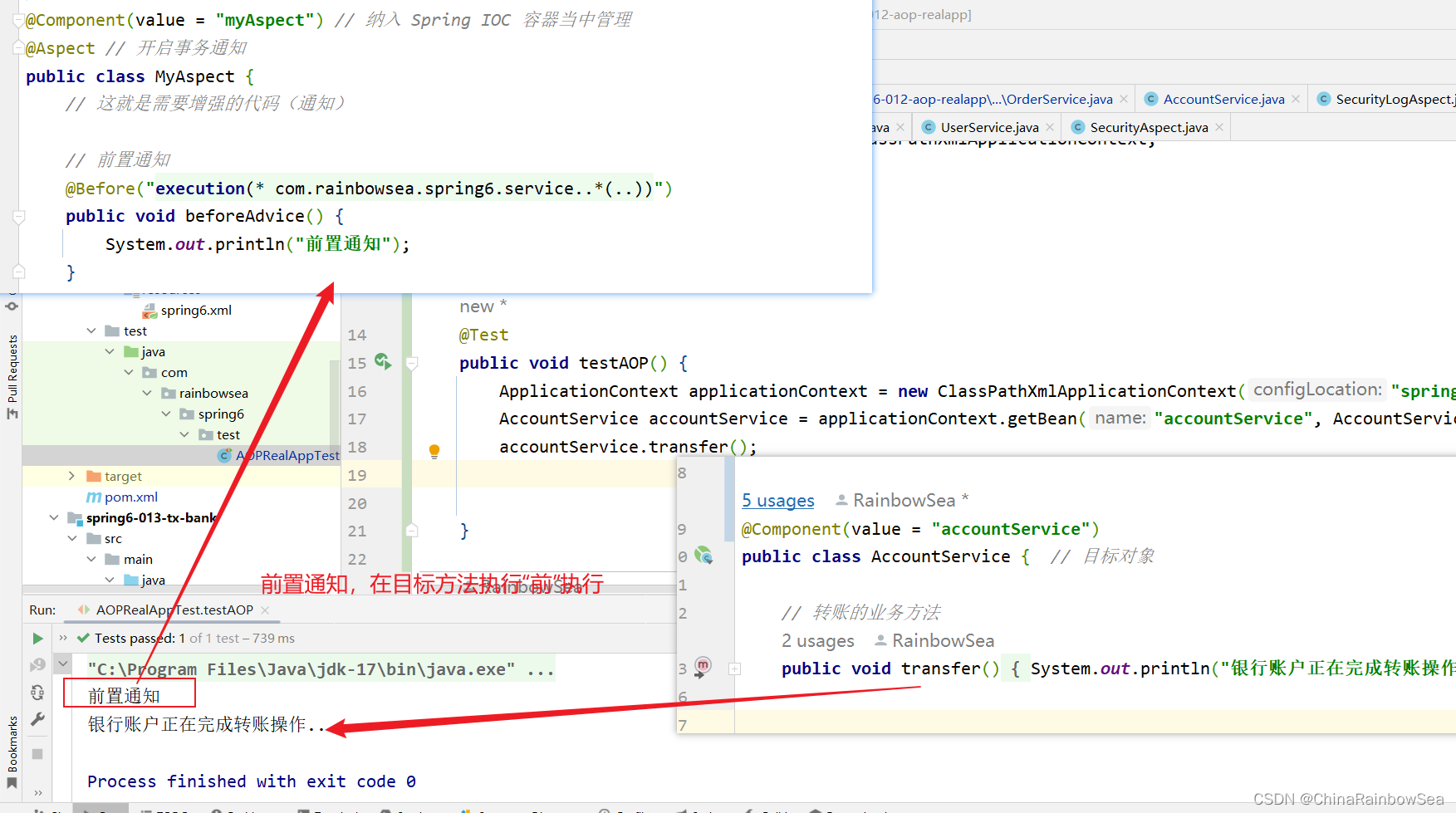
@AfterReturning 目标方法执行之后的通知前置通知使用: @AfterReturning(切面表达式)

import org.springframework.stereotype.Component;
/**
* 切面类
*/
@Component(value = "myAspect") // 纳入 Spring IOC 容器当中管理
@Aspect // 开启事务通知
public class MyAspect {
// 这就是需要增强的代码(通知)
// 后置通知
@AfterReturning("execution(* com.rainbowsea.spring6.service..*(..))")
public void afterReturningAdvice() {
System.out.println("后置通知");
}
}
复制
@Around 目标方法之前添加通知,通知目标方法执行之后添加通知环绕通知需要加上:public void aroundAdvice(ProceedingJoinPoint joinPoint) throws Throwable,ProceedingJoinPoint joinPoint 参数,同时需要把 异常抛出去,在环绕通知当中需要:自己手动通过 : ProceedingJoinPoint joinPoint.procced() 调用目标方法。才会执行目标方法,不然,是不会执行目标类当中的目标方法的。
// 这个JoinPoint joinPoint ,在Spring容器调用这个方法的时候自动传过来 // 我们可以直接用,用这个 JoinPoint joinPoint 干啥? // Signature signature = joinPoint.getSignature(); 获取目标方法的签名 // 通过方法的签名可以获取到一个方法的具体信息 // 获取目标方法的方法名复制
环绕通知使用: @Around(切面表达式)
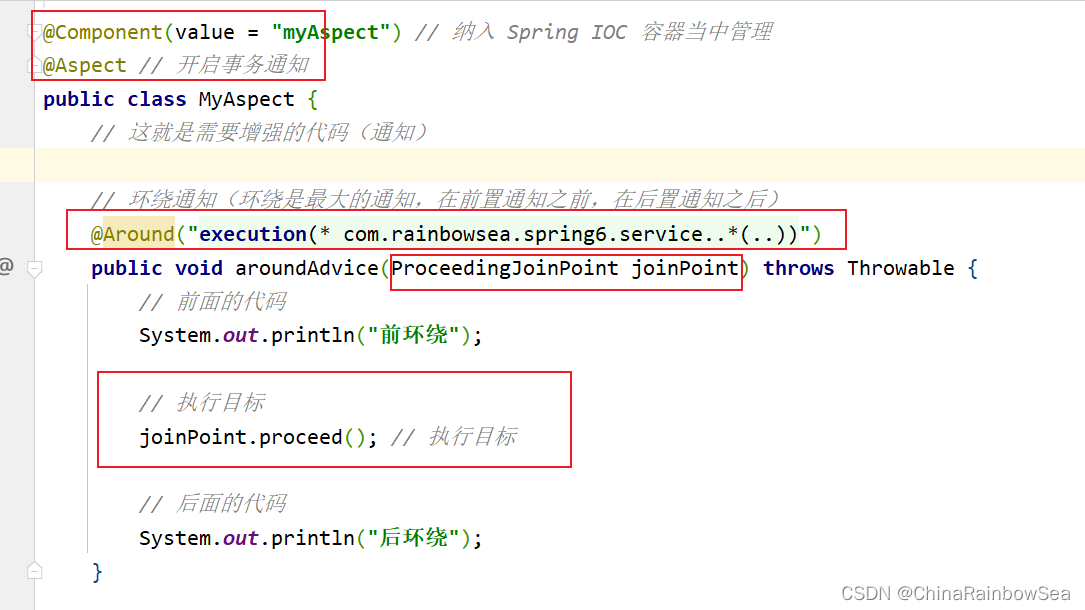
/**
* 切面类
*/
@Component(value = "myAspect") // 纳入 Spring IOC 容器当中管理
@Aspect // 开启事务通知
public class MyAspect {
// 这就是需要增强的代码(通知)
// 环绕通知(环绕是最大的通知,在前置通知之前,在后置通知之后)
@Around("execution(* com.rainbowsea.spring6.service..*(..))")
public void aroundAdvice(ProceedingJoinPoint joinPoint) throws Throwable {
// 前面的代码
System.out.println("前环绕");
// 执行目标
joinPoint.proceed(); // 执行目标
// 后面的代码
System.out.println("后环绕");
}
}
复制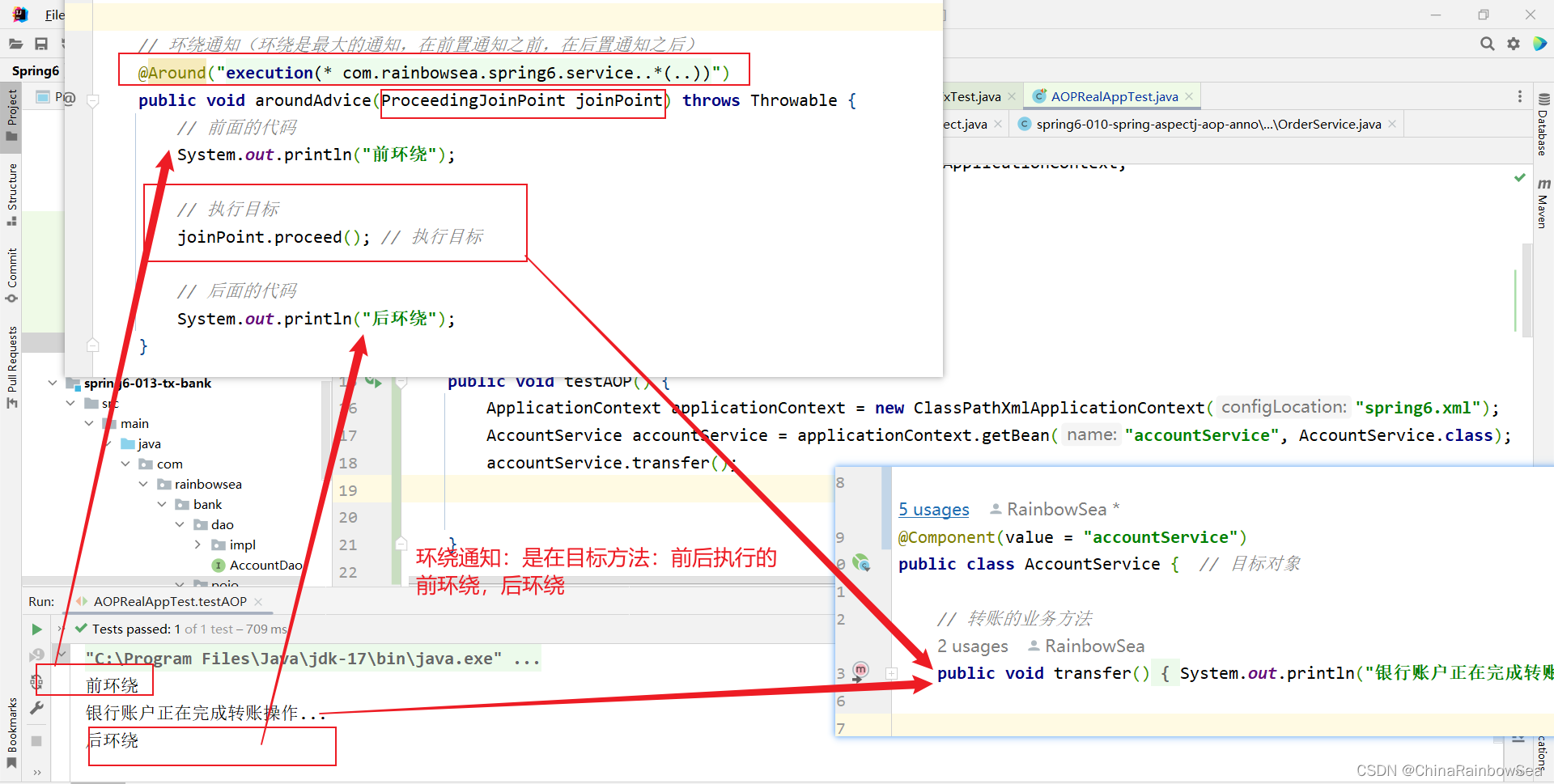
@AfterThrowing 发生异常之后执行的通知,没发生异常是不会执行的。异常通知使用: @AfterThrowing(切面表达式)
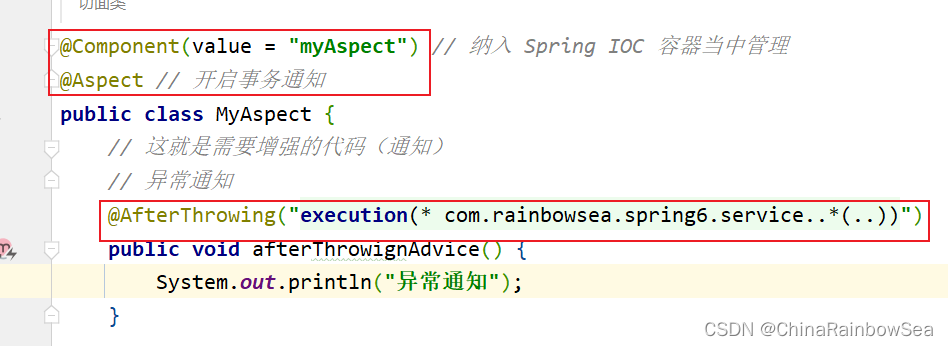
/**
* 切面类
*/
@Component(value = "myAspect") // 纳入 Spring IOC 容器当中管理
@Aspect // 开启事务通知
public class MyAspect {
// 这就是需要增强的代码(通知)
// 异常通知
@AfterThrowing("execution(* com.rainbowsea.spring6.service..*(..))")
public void afterThrowignAdvice() {
System.out.println("异常通知");
}
}
复制异常通知:没有异常,就不会执行异常通知的操作。
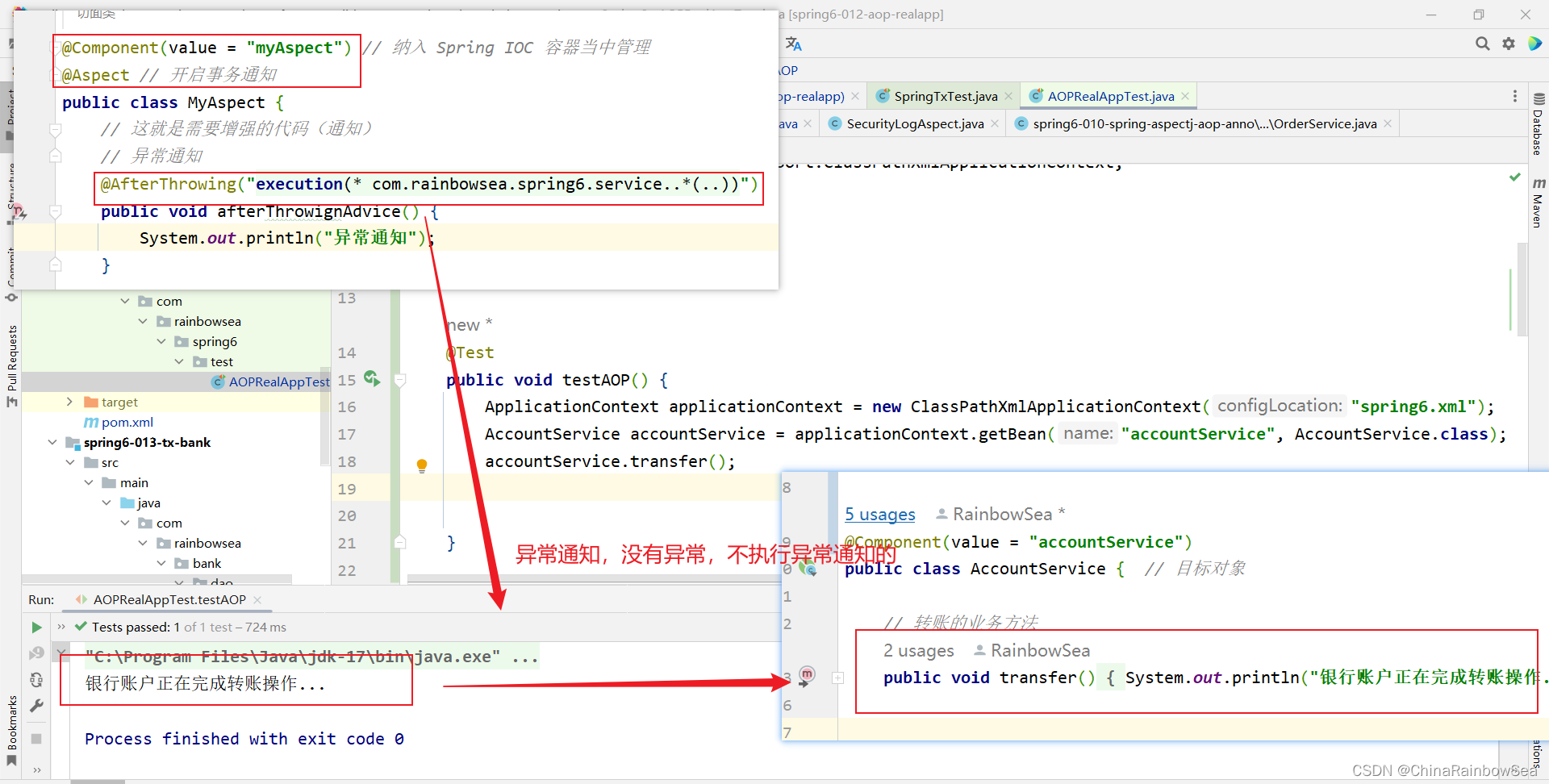
这里,我们添加模拟上一个 null 指针异常进行,测试异常通知的执行。
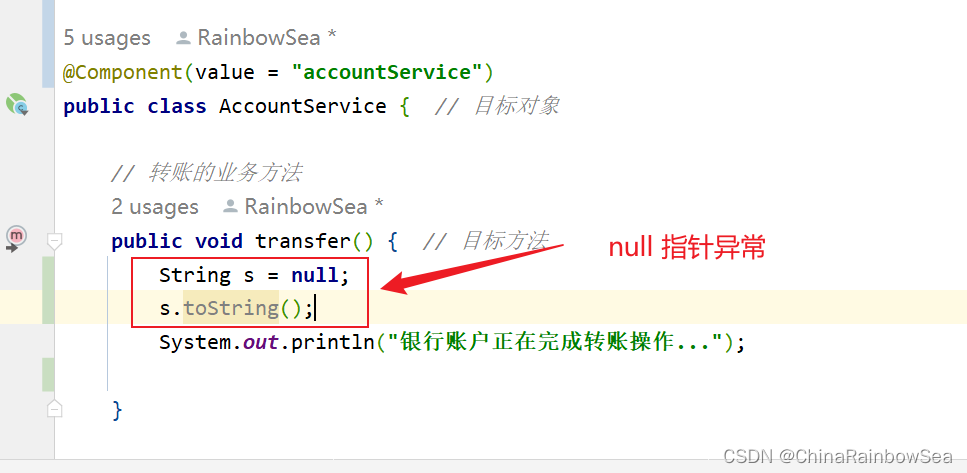
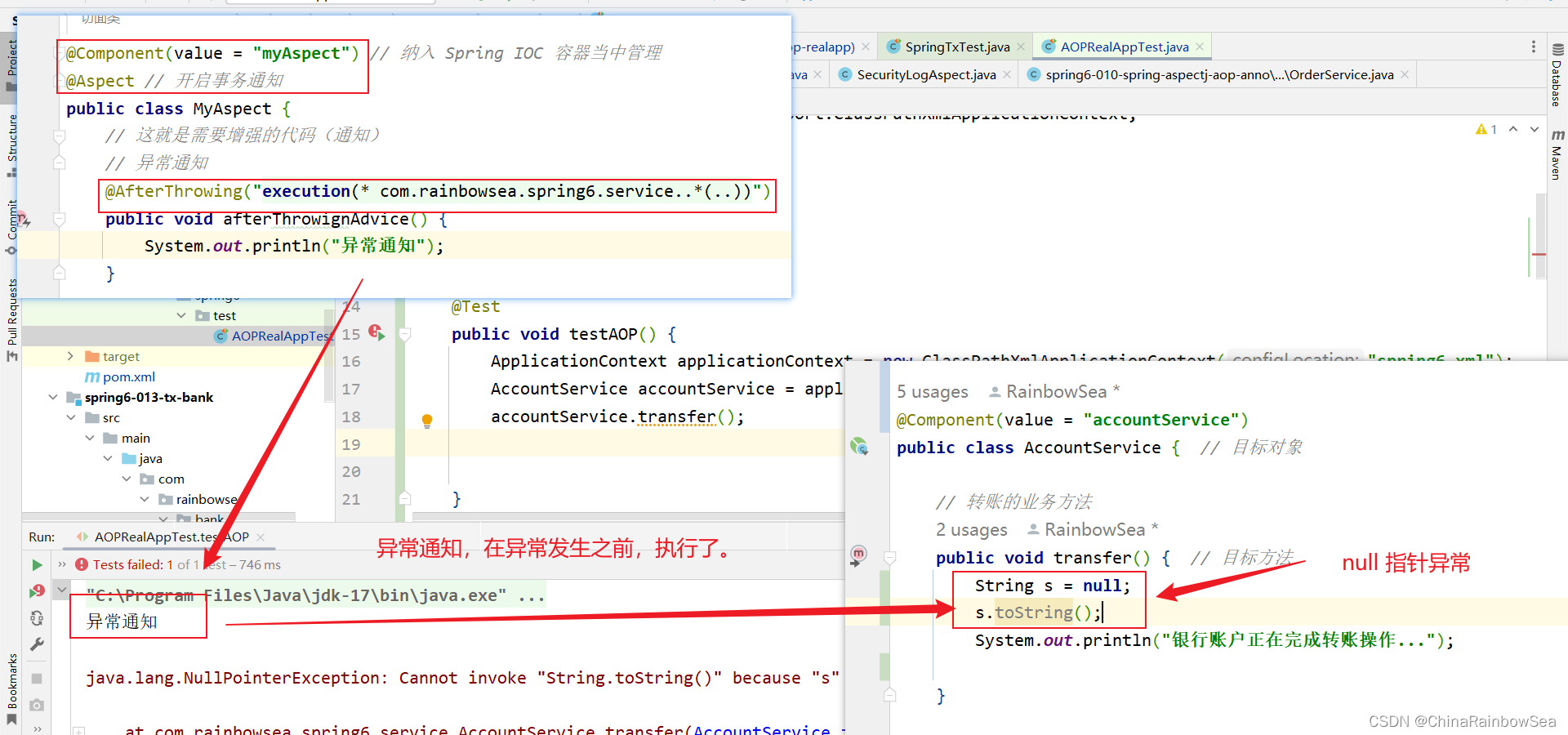
@After 放在 finally 语句块当中的通知最终通知使用: @After(切面表达式)。最终通知:无论是否存在异常都是在最后都会执行的。
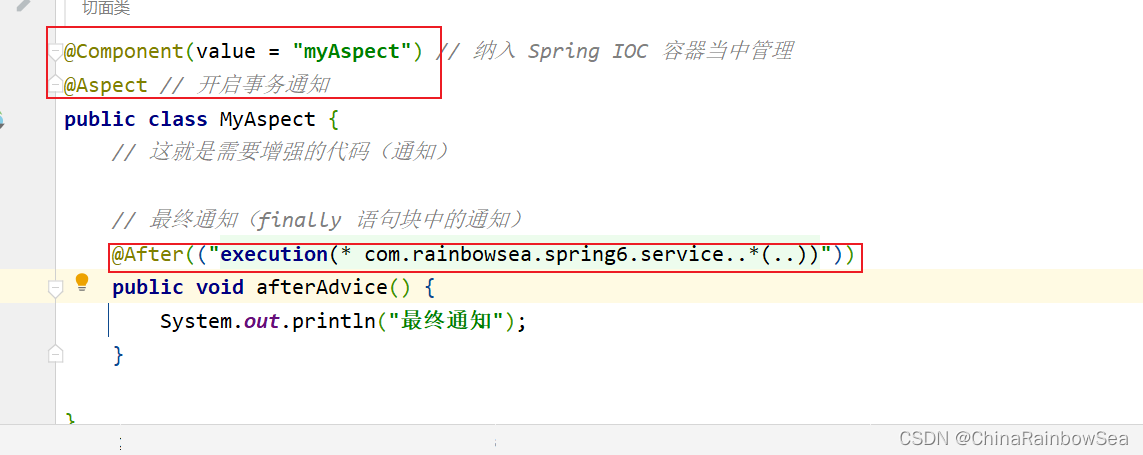
/**
* 切面类
*/
@Component(value = "myAspect") // 纳入 Spring IOC 容器当中管理
@Aspect // 开启事务通知
public class MyAspect {
// 这就是需要增强的代码(通知)
// 最终通知(finally 语句块中的通知)
@After(("execution(* com.rainbowsea.spring6.service..*(..))"))
public void afterAdvice() {
System.out.println("最终通知");
}
}
复制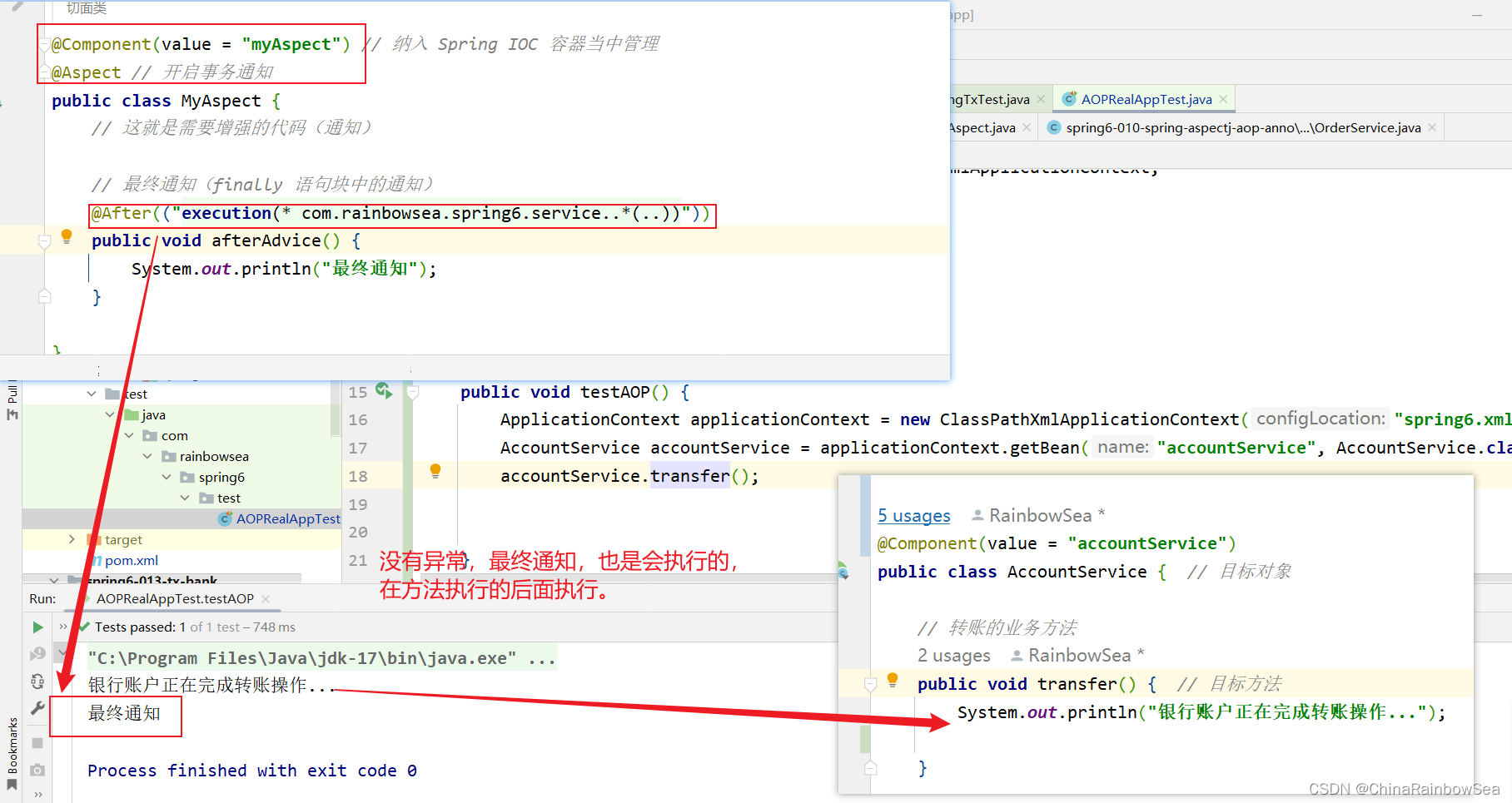
有异常,最终通知,也是会执行的。
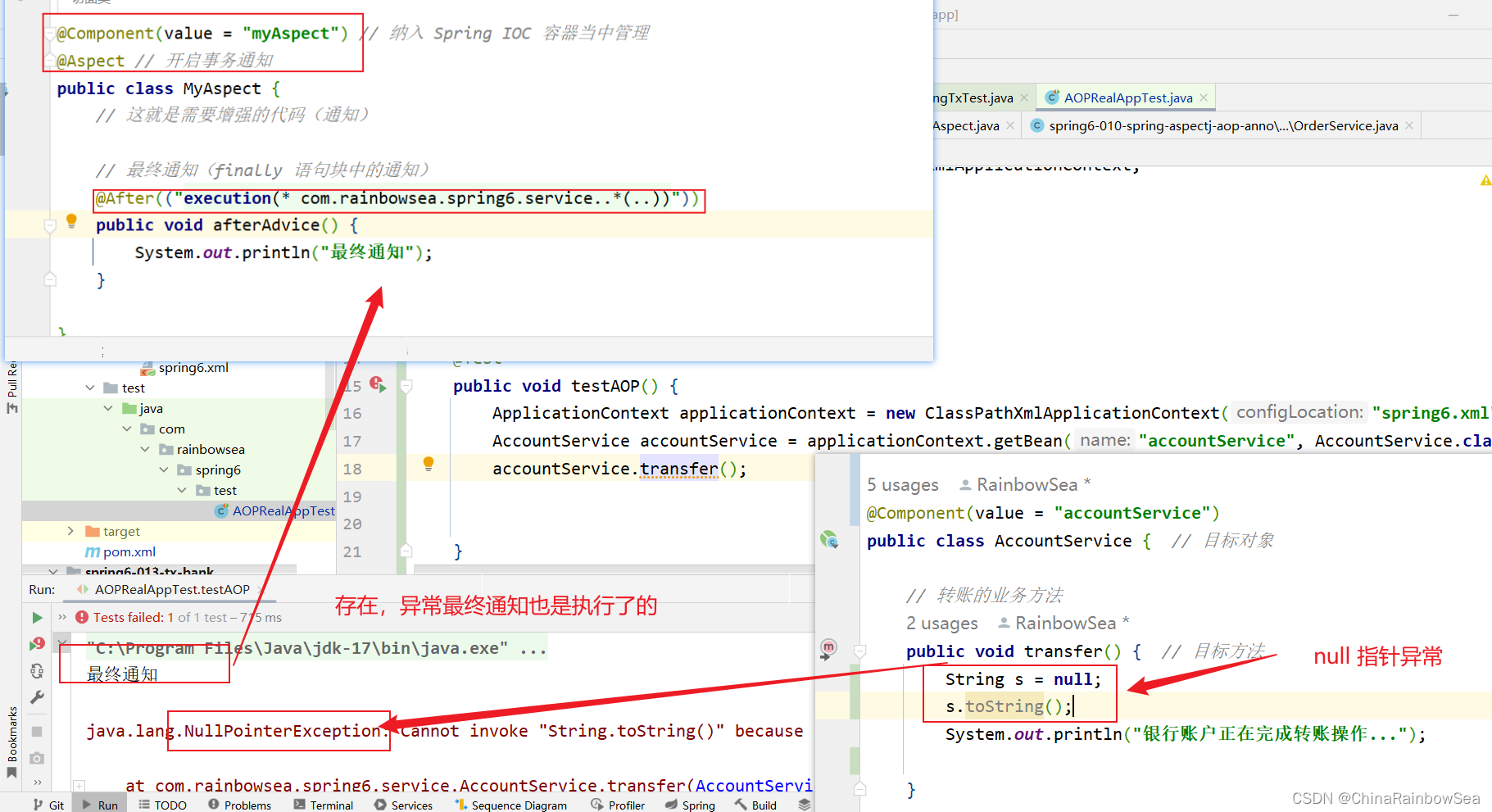
通过测试得知,当发生异常之后,最终通知也会执行,因为最终通知@After会出现在finally语句块中。
出现异常之后,后置通知和环绕通知的结束部分不会执行。
下面,我们集合五种通知类型,同时发生,看看他们在通知当中的执行顺序又是如何的
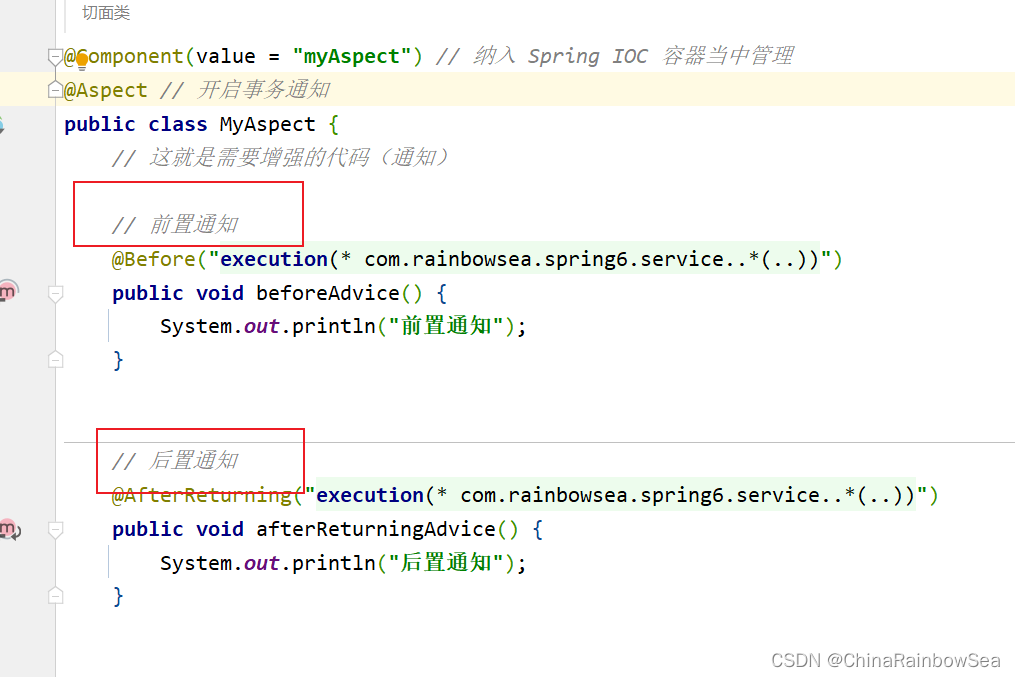
package com.rainbowsea.spring6.service;
import org.aspectj.lang.ProceedingJoinPoint;
import org.aspectj.lang.annotation.After;
import org.aspectj.lang.annotation.AfterReturning;
import org.aspectj.lang.annotation.AfterThrowing;
import org.aspectj.lang.annotation.Around;
import org.aspectj.lang.annotation.Aspect;
import org.aspectj.lang.annotation.Before;
import org.springframework.stereotype.Component;
/**
* 切面类
*/
@Component(value = "myAspect") // 纳入 Spring IOC 容器当中管理
@Aspect // 开启事务通知
public class MyAspect {
// 这就是需要增强的代码(通知)
// 前置通知
@Before("execution(* com.rainbowsea.spring6.service..*(..))")
public void beforeAdvice() {
System.out.println("前置通知");
}
// 后置通知
@AfterReturning("execution(* com.rainbowsea.spring6.service..*(..))")
public void afterReturningAdvice() {
System.out.println("后置通知");
}
// 环绕通知(环绕是最大的通知,在前置通知之前,在后置通知之后)
@Around("execution(* com.rainbowsea.spring6.service..*(..))")
public void aroundAdvice(ProceedingJoinPoint joinPoint) throws Throwable {
// 前面的代码
System.out.println("前环绕");
// 执行目标
joinPoint.proceed(); // 执行目标
// 后面的代码
System.out.println("后环绕");
}
// 异常通知
@AfterThrowing("execution(* com.rainbowsea.spring6.service..*(..))")
public void afterThrowignAdvice() {
System.out.println("异常通知");
}
// 最终通知(finally 语句块中的通知)
@After(("execution(* com.rainbowsea.spring6.service..*(..))"))
public void afterAdvice() {
System.out.println("最终通知");
}
}
复制
有异常的:

前环绕
前置通知
银行账户正在完成转账操作...
后置通知
最终通知
后环绕总结:
环绕通知是范围最大的(也是是说,环绕通知的(前环绕)是在所有通知的最前面执行的,而环绕通知的(后环绕)是在所有通知的最后面执行的)。
前环绕
前置通知
异常通知
最终通知存在异常时,异常通知执行了,但是后面的:后置通知,环绕通知的(后环绕)通知,并不会执行,被异常给中断了。
我们知道,业务流程当中不一定只有一个切面,可能有的切面控制事务,有的记录日志,有的进安全控制,如果多个切面的话,顺序如何控制:关于这一点:我们可以使用@Order 注解来标识切面类,为@Order注解的 value 指定一个整数型的数字,数字越小,优先级越高。
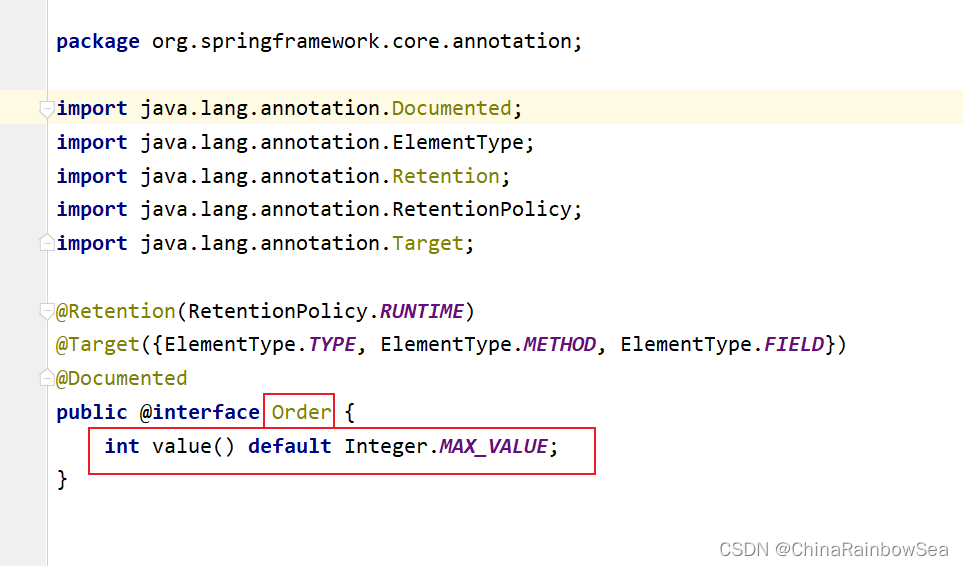
这里我们分别定义两个通知:分别为 安全方面的通知,和日志方面的通知。如下:

package com.rainbowsea.spring6.service;
import org.aspectj.lang.annotation.Aspect;
import org.aspectj.lang.annotation.Before;
import org.springframework.stereotype.Component;
/**
* 安全事务
*/
@Component // 将该 Bean 交给Spring IOC 容器管理上
@Aspect // 开启事务
public class SecureAspect {
// 前置通知
// 安全
@Before("execution(* com.rainbowsea.spring6.service..*(..))")
public void beforeAdvice() {
System.out.println("安全方面的:前置通知");
}
}
复制package com.rainbowsea.spring6.service;
import org.aspectj.lang.annotation.Aspect;
import org.aspectj.lang.annotation.Before;
import org.springframework.stereotype.Component;
/**
* 日志通知
*/
@Component // 将该 Bean 加入到 Spring IOC 容器当中管理
@Aspect // 开启事务
public class LogAspect {
// 前置通知
@Before("execution(* com.rainbowsea.spring6.service..*(..))")
public void beforeAdvice() {
System.out.println("日志的通知方面的:前置通知");
}
}
复制没有添加@Order 注解的通知顺序如下:
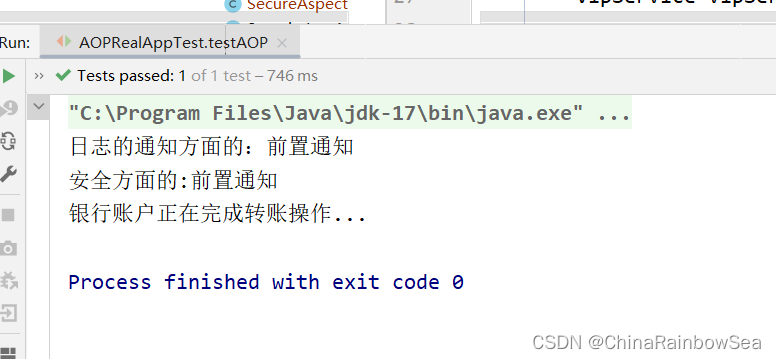
我们添加@Order注解的整数值来切换顺序,这里,我们将安全方面的通知,放在最前面执行,执行测试程序:
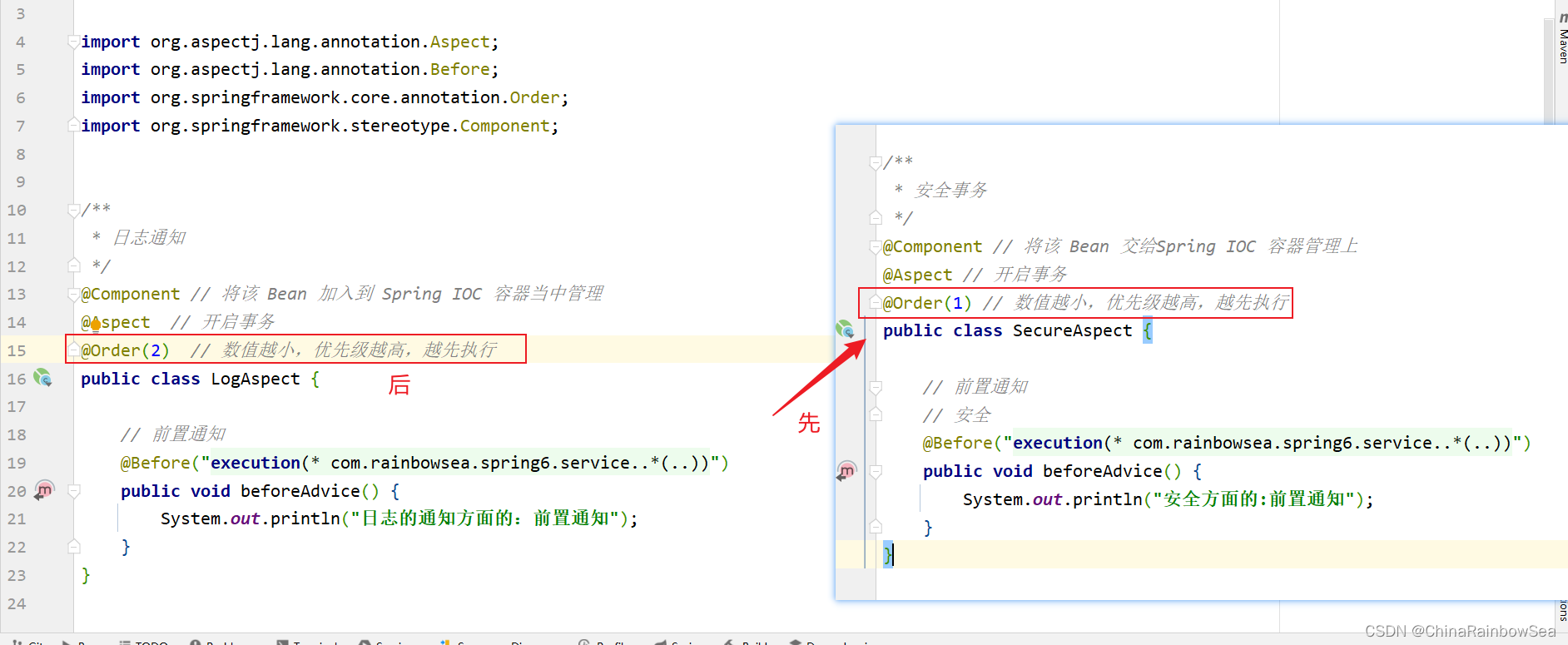
package com.rainbowsea.spring6.service;
import org.aspectj.lang.annotation.Aspect;
import org.aspectj.lang.annotation.Before;
import org.springframework.core.annotation.Order;
import org.springframework.stereotype.Component;
/**
* 日志通知
*/
@Component // 将该 Bean 加入到 Spring IOC 容器当中管理
@Aspect // 开启事务
@Order(2) // 数值越小,优先级越高,越先执行
public class LogAspect {
// 前置通知
@Before("execution(* com.rainbowsea.spring6.service..*(..))")
public void beforeAdvice() {
System.out.println("日志的通知方面的:前置通知");
}
}
复制package com.rainbowsea.spring6.service;
import org.aspectj.lang.annotation.Aspect;
import org.aspectj.lang.annotation.Before;
import org.springframework.core.annotation.Order;
import org.springframework.stereotype.Component;
/**
* 安全事务
*/
@Component // 将该 Bean 交给Spring IOC 容器管理上
@Aspect // 开启事务
@Order(1) // 数值越小,优先级越高,越先执行
public class SecureAspect {
// 前置通知
// 安全
@Before("execution(* com.rainbowsea.spring6.service..*(..))")
public void beforeAdvice() {
System.out.println("安全方面的:前置通知");
}
}
复制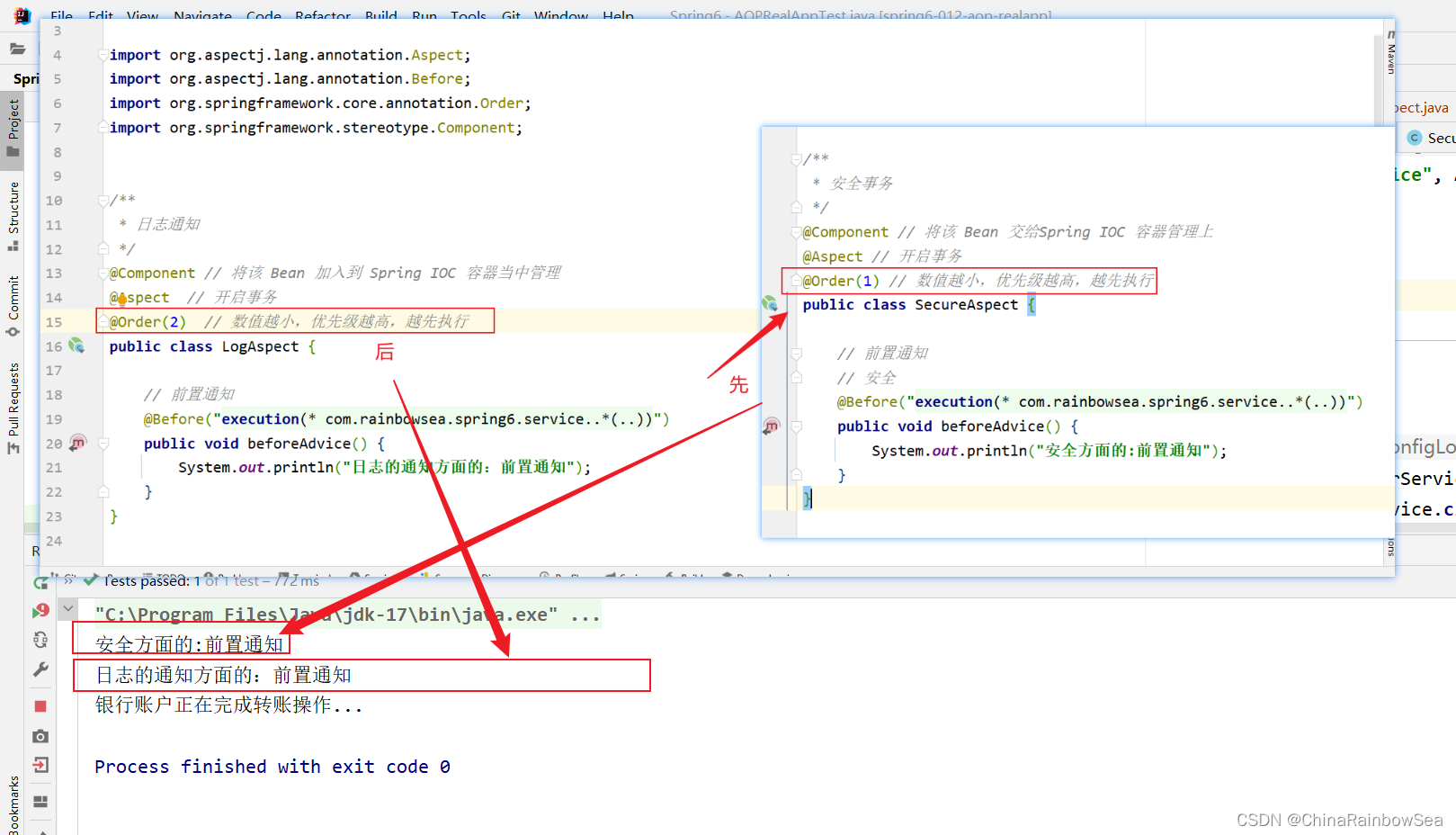
观看以下代码中的切点表达式:
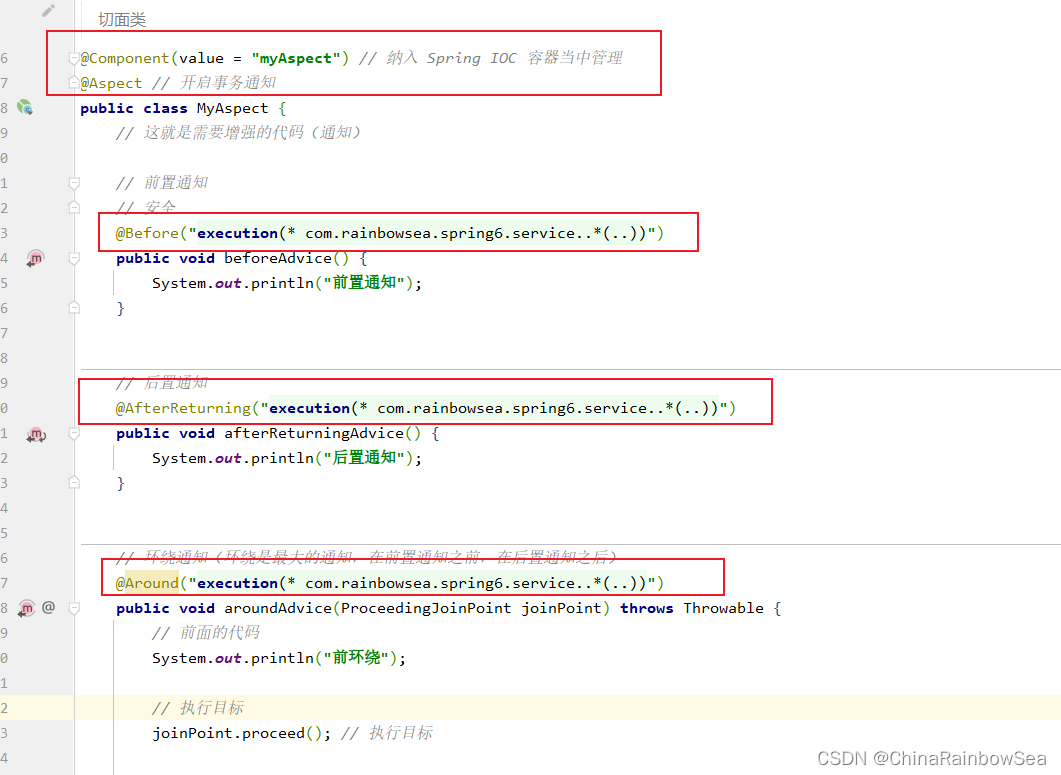
package com.rainbowsea.spring6.service;
import org.aspectj.lang.ProceedingJoinPoint;
import org.aspectj.lang.annotation.After;
import org.aspectj.lang.annotation.AfterReturning;
import org.aspectj.lang.annotation.AfterThrowing;
import org.aspectj.lang.annotation.Around;
import org.aspectj.lang.annotation.Aspect;
import org.aspectj.lang.annotation.Before;
import org.springframework.stereotype.Component;
/**
* 切面类
*/
@Component(value = "myAspect") // 纳入 Spring IOC 容器当中管理
@Aspect // 开启事务通知
public class MyAspect {
// 这就是需要增强的代码(通知)
// 前置通知
// 安全
@Before("execution(* com.rainbowsea.spring6.service..*(..))")
public void beforeAdvice() {
System.out.println("前置通知");
}
// 后置通知
@AfterReturning("execution(* com.rainbowsea.spring6.service..*(..))")
public void afterReturningAdvice() {
System.out.println("后置通知");
}
// 环绕通知(环绕是最大的通知,在前置通知之前,在后置通知之后)
@Around("execution(* com.rainbowsea.spring6.service..*(..))")
public void aroundAdvice(ProceedingJoinPoint joinPoint) throws Throwable {
// 前面的代码
System.out.println("前环绕");
// 执行目标
joinPoint.proceed(); // 执行目标
// 后面的代码
System.out.println("后环绕");
}
// 异常通知
@AfterThrowing("execution(* com.rainbowsea.spring6.service..*(..))")
public void afterThrowignAdvice() {
System.out.println("异常通知");
}
// 最终通知(finally 语句块中的通知)
@After(("execution(* com.rainbowsea.spring6.service..*(..))"))
public void afterAdvice() {
System.out.println("最终通知");
}
}
复制上述的缺点是:
- 第一:切点表达式重复写了多次,没有得到复用。
- 第二:如果要修改切点表达式,需要修改多处,难维护。
可以这样做:将切点表达式单独的定义出来,在需要的位置引入即可,如下:
我们可以使用:@Pointcut 注解来定义独立的切点表达式。
注意这个 @Pointcut 注解标注的方法随意,只是起到一个能够让@Pointcut注解编写的位置。

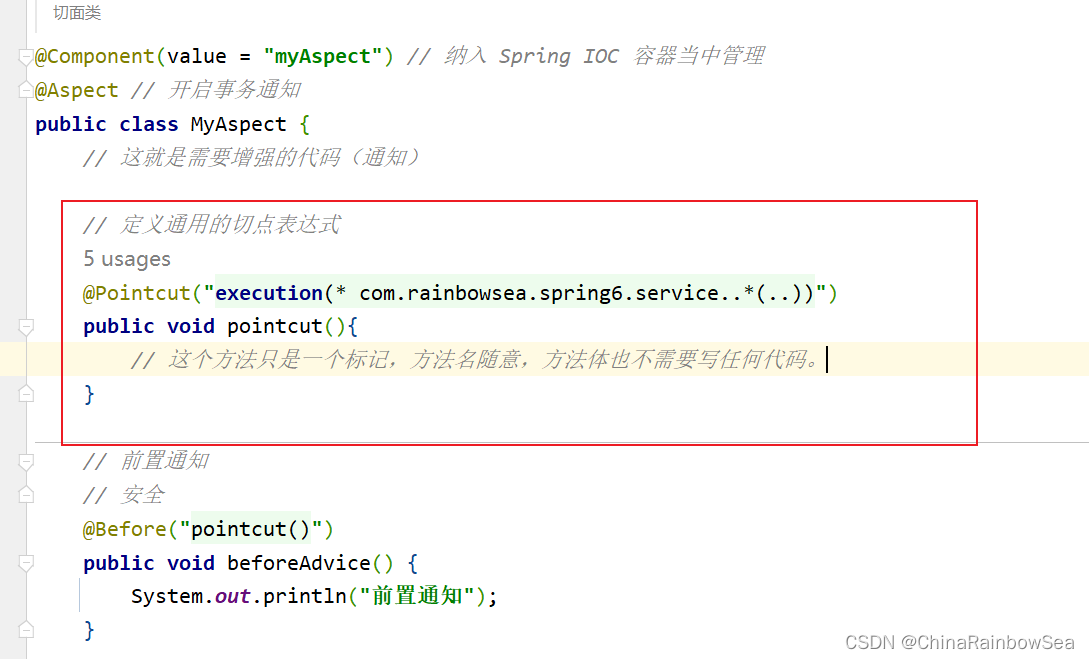
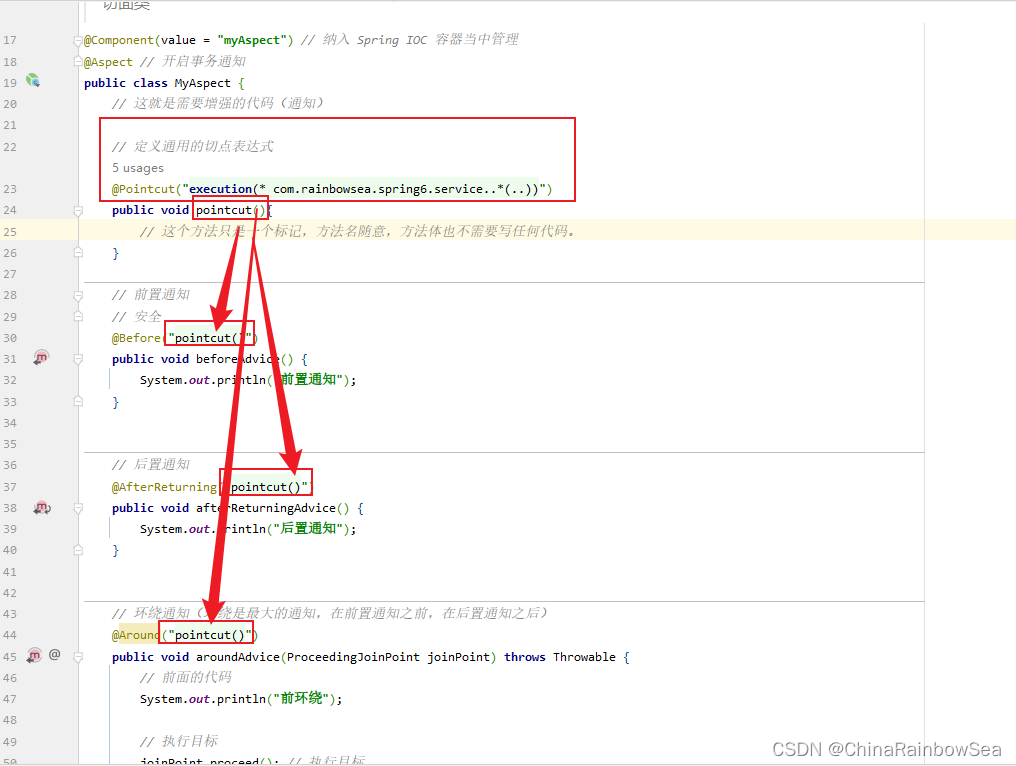
package com.rainbowsea.spring6.service;
import org.aspectj.lang.ProceedingJoinPoint;
import org.aspectj.lang.annotation.After;
import org.aspectj.lang.annotation.AfterReturning;
import org.aspectj.lang.annotation.AfterThrowing;
import org.aspectj.lang.annotation.Around;
import org.aspectj.lang.annotation.Aspect;
import org.aspectj.lang.annotation.Before;
import org.aspectj.lang.annotation.Pointcut;
import org.springframework.stereotype.Component;
/**
* 切面类
*/
@Component(value = "myAspect") // 纳入 Spring IOC 容器当中管理
@Aspect // 开启事务通知
public class MyAspect {
// 这就是需要增强的代码(通知)
// 定义通用的切点表达式
@Pointcut("execution(* com.rainbowsea.spring6.service..*(..))")
public void pointcut(){
// 这个方法只是一个标记,方法名随意,方法体也不需要写任何代码。
}
// 前置通知
// 安全
@Before("pointcut()")
public void beforeAdvice() {
System.out.println("前置通知");
}
// 后置通知
@AfterReturning("pointcut()")
public void afterReturningAdvice() {
System.out.println("后置通知");
}
// 环绕通知(环绕是最大的通知,在前置通知之前,在后置通知之后)
@Around("pointcut()")
public void aroundAdvice(ProceedingJoinPoint joinPoint) throws Throwable {
// 前面的代码
System.out.println("前环绕");
// 执行目标
joinPoint.proceed(); // 执行目标
// 后面的代码
System.out.println("后环绕");
}
// 异常通知
@AfterThrowing("pointcut()")
public void afterThrowignAdvice() {
System.out.println("异常通知");
}
// 最终通知(finally 语句块中的通知)
@After(("pointcut()"))
public void afterAdvice() {
System.out.println("最终通知");
}
}
复制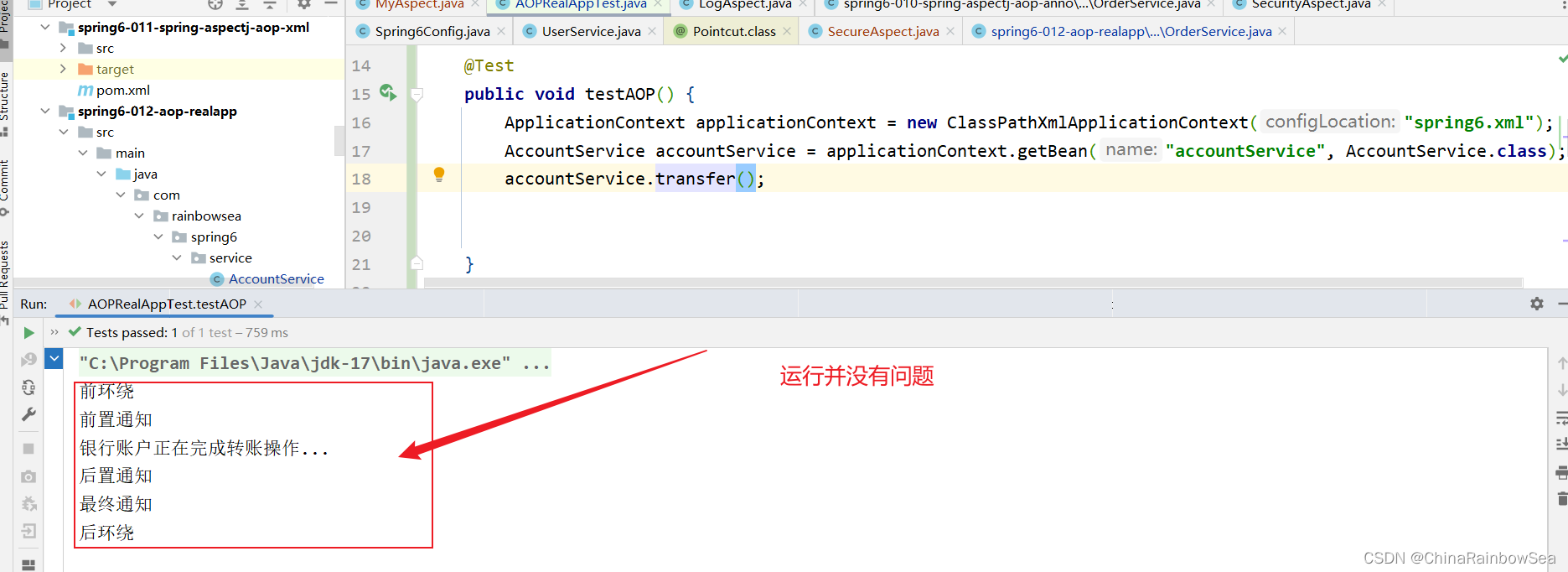
就是编写一个类,在这个类上面使用大量注解来代替 spring.xml的配置文件,spring配置文件消失了,如下:
@Configuration // 代替spring.xml 文件
@ComponentScan(value = {"com.rainbowsea.spring6.service"}) // 组件扫描
@EnableAspectJAutoProxy(proxyTargetClass = true) // 启用 aspectj的自动代理机制
复制
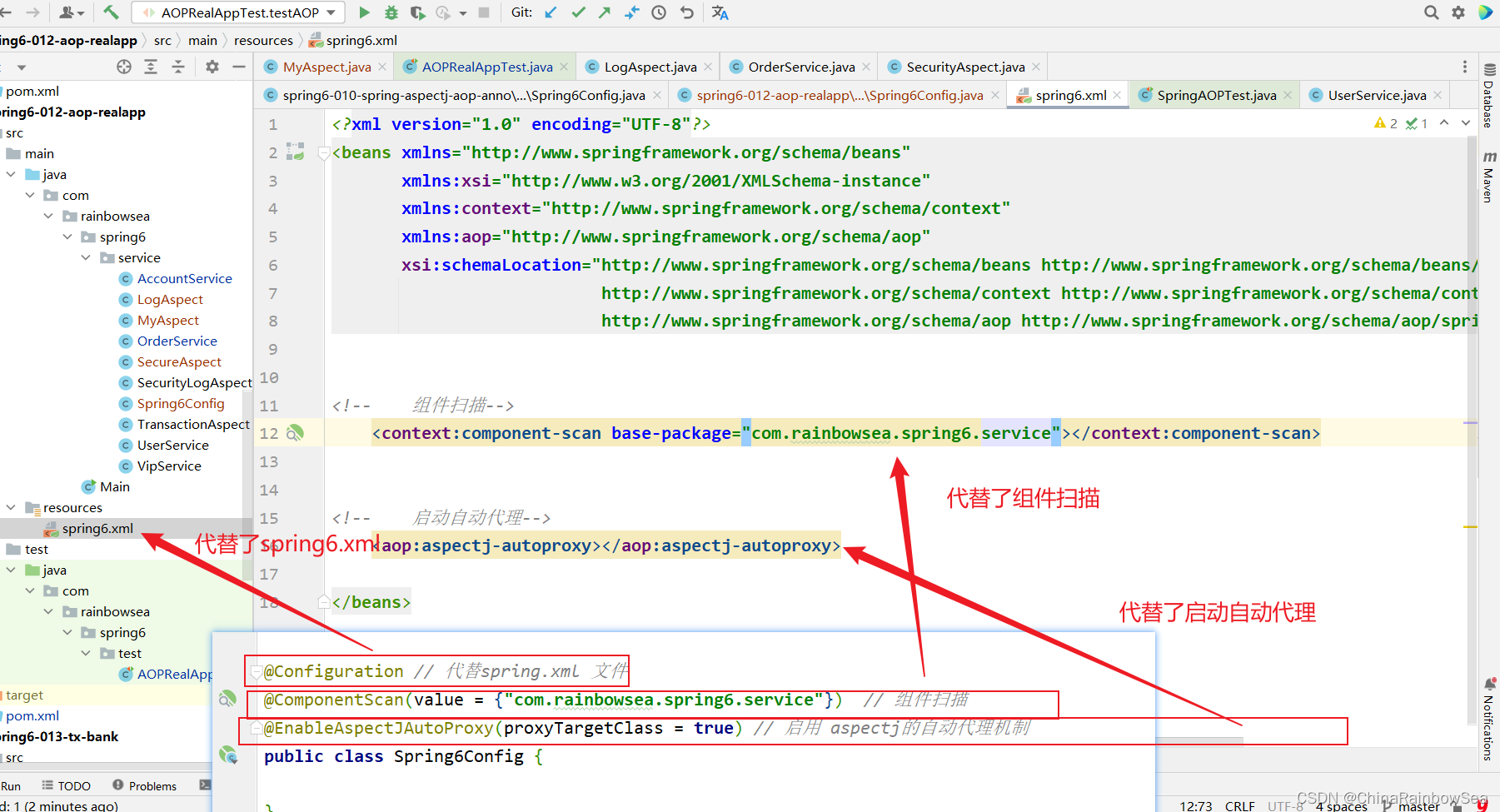
package com.rainbowsea.spring6.service;
import org.springframework.context.annotation.ComponentScan;
import org.springframework.context.annotation.Configuration;
import org.springframework.context.annotation.EnableAspectJAutoProxy;
@Configuration // 代替spring.xml 文件
@ComponentScan(value = {"com.rainbowsea.spring6.service"}) // 组件扫描
@EnableAspectJAutoProxy(proxyTargetClass = true) // 启用 aspectj的自动代理机制
public class Spring6Config {
}
复制测试程序也变化了:因为我这里是通过定义的一个配置类 代替 spring.xml 文件的需要用的是:new AnnotationConfigApplicationContext(配置类.class),而不再是: new ClassPathXmlApplicationContext()了。

public class AOPRealAppTest {
@Test
public void testAOPWithAllAnnotation() {
ApplicationContext applicationContext = new AnnotationConfigApplicationContext(Spring6Config.class);
AccountService accountService = applicationContext.getBean("accountService", AccountService.class);
accountService.transfer();
}
复制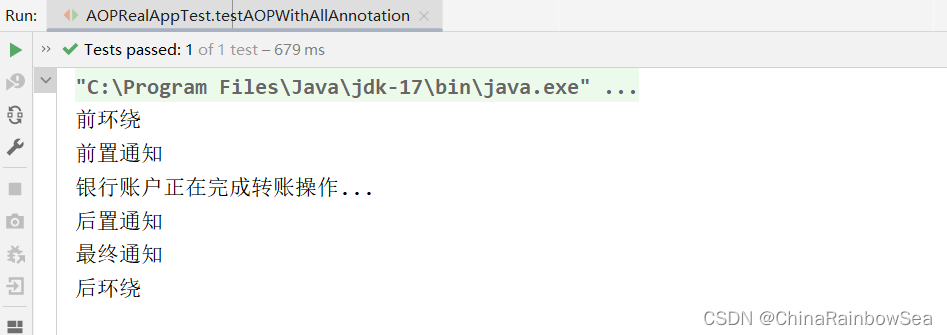
第一步: 编写目标类。因为这里我们用的是 xml 配置方式的,不是注解的方式,所有就不用注解了。
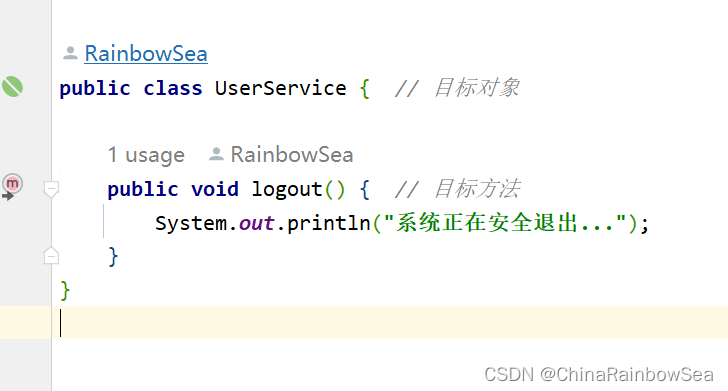
package com.rainbowsea.spring6.service;
public class UserService { // 目标对象
public void logout() { // 目标方法
System.out.println("系统正在安全退出...");
}
}
复制第二步: 编写切面类,并且编写通知
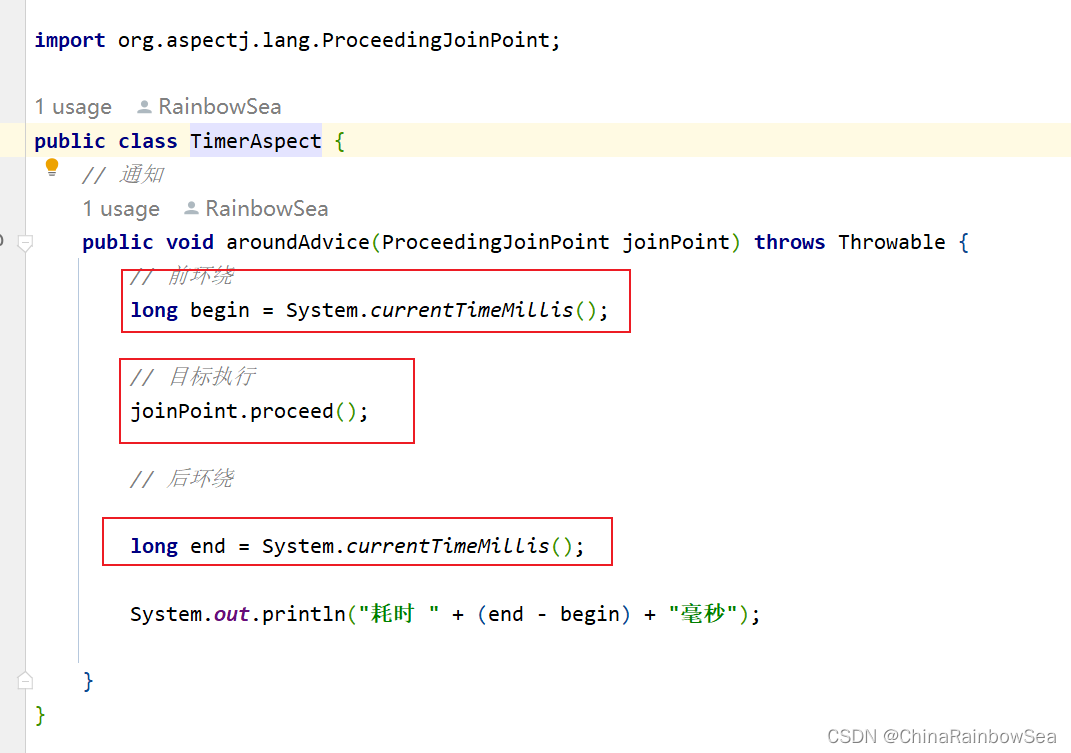
第三步: 编写spring配置文件
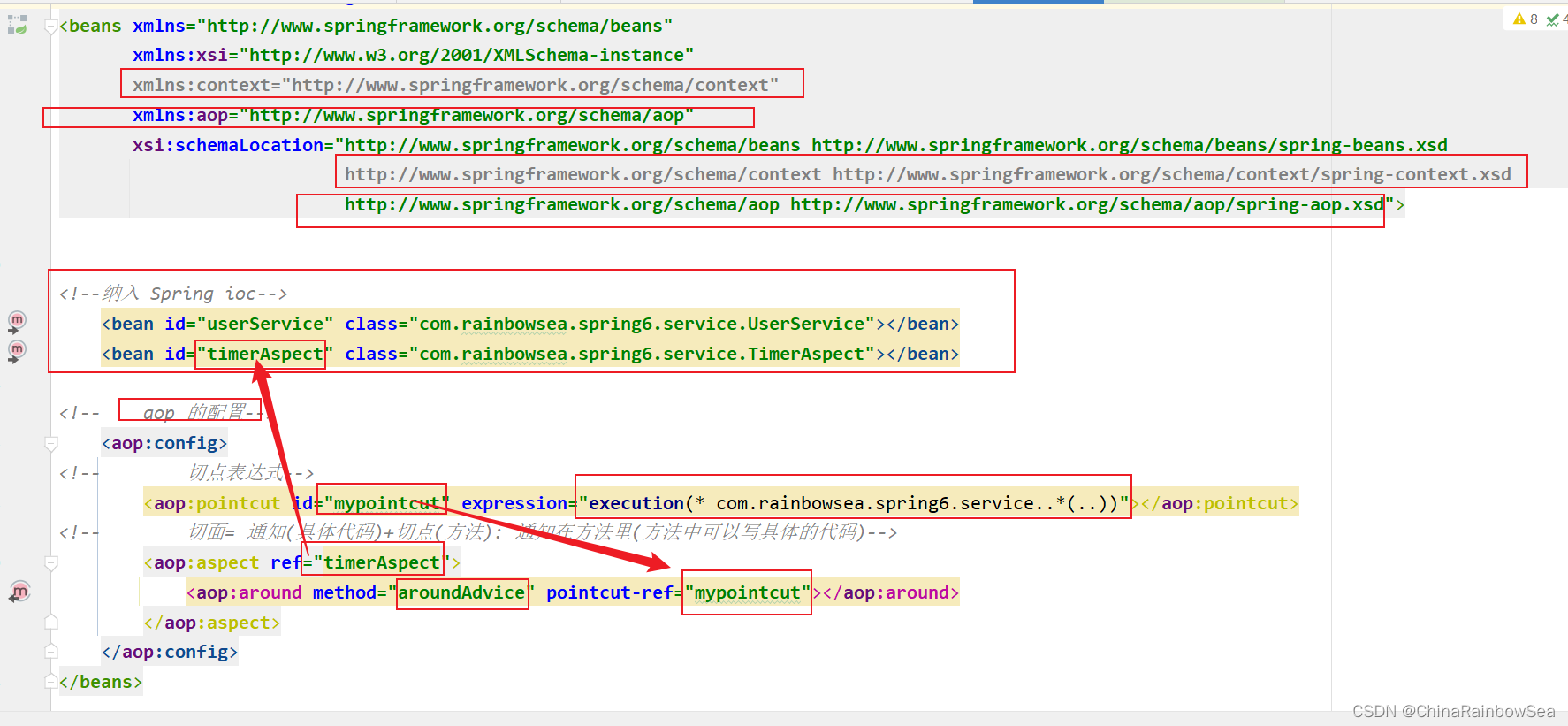

<?xml version="1.0" encoding="UTF-8"?>
<beans xmlns="http://www.springframework.org/schema/beans"
xmlns:xsi="http://www.w3.org/2001/XMLSchema-instance"
xmlns:context="http://www.springframework.org/schema/context"
xmlns:aop="http://www.springframework.org/schema/aop"
xsi:schemaLocation="http://www.springframework.org/schema/beans http://www.springframework.org/schema/beans/spring-beans.xsd
http://www.springframework.org/schema/context http://www.springframework.org/schema/context/spring-context.xsd
http://www.springframework.org/schema/aop http://www.springframework.org/schema/aop/spring-aop.xsd">
<!--纳入 Spring ioc-->
<bean id="userService" class="com.rainbowsea.spring6.service.UserService"></bean>
<bean id="timerAspect" class="com.rainbowsea.spring6.service.TimerAspect"></bean>
<!-- aop 的配置-->
<aop:config>
<!-- 切点表达式-->
<aop:pointcut id="mypointcut" expression="execution(* com.rainbowsea.spring6.service..*(..))"></aop:pointcut>
<!-- 切面= 通知(具体代码)+切点(方法): 通知在方法里(方法中可以写具体的代码)-->
<aop:aspect ref="timerAspect">
<aop:around method="aroundAdvice" pointcut-ref="mypointcut"></aop:around>
</aop:aspect>
</aop:config>
</beans>
复制测试程序:
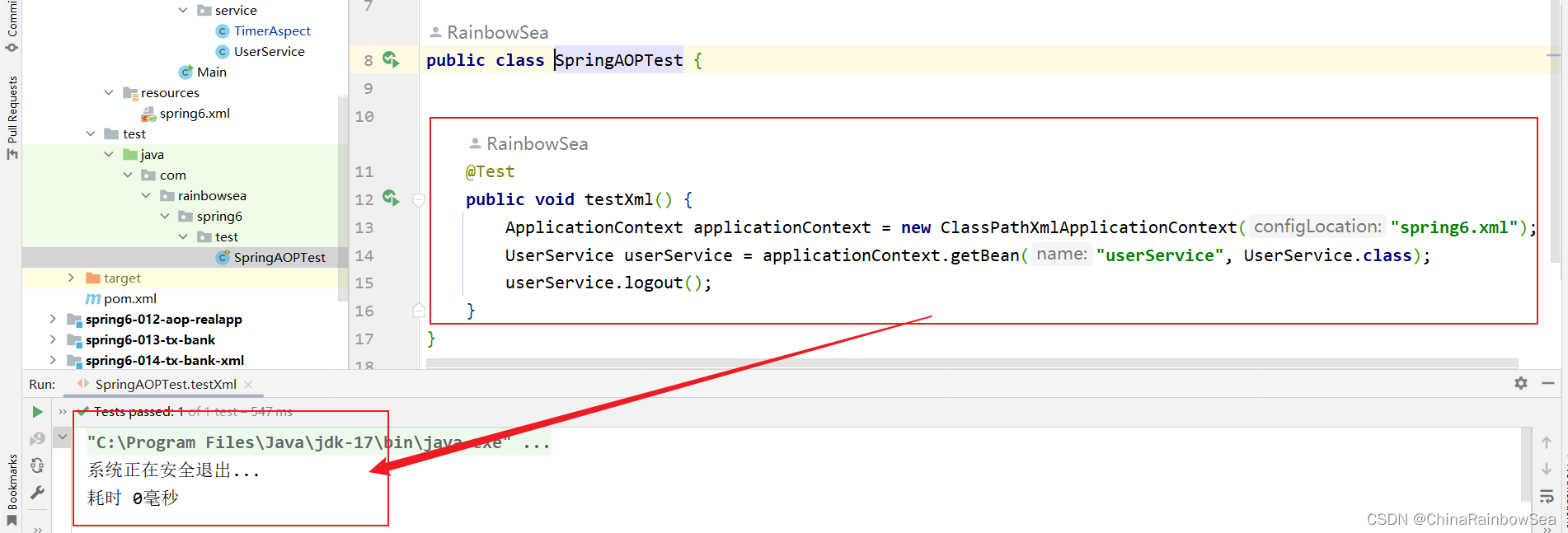
package com.rainbowsea.spring6.test;
import com.rainbowsea.spring6.service.UserService;
import org.junit.Test;
import org.springframework.context.ApplicationContext;
import org.springframework.context.support.ClassPathXmlApplicationContext;
public class SpringAOPTest {
@Test
public void testXml() {
ApplicationContext applicationContext = new ClassPathXmlApplicationContext("spring6.xml");
UserService userService = applicationContext.getBean("userService", UserService.class);
userService.logout();
}
}
复制项目中的事务控制是在所难免的。在一个业务流程当中,可能需要多条DML语句共同完成,为了保证数据的安全,这多条DML语句要么同时成功,要么同时失败。这就需要添加事务控制的代码。例如以下伪代码:
class 业务类1{
public void 业务方法1(){
try{
// 开启事务
startTransaction();
// 执行核心业务逻辑
step1();
step2();
step3();
....
// 提交事务
commitTransaction();
}catch(Exception e){
// 回滚事务
rollbackTransaction();
}
}
public void 业务方法2(){
try{
// 开启事务
startTransaction();
// 执行核心业务逻辑
step1();
step2();
step3();
....
// 提交事务
commitTransaction();
}catch(Exception e){
// 回滚事务
rollbackTransaction();
}
}
public void 业务方法3(){
try{
// 开启事务
startTransaction();
// 执行核心业务逻辑
step1();
step2();
step3();
....
// 提交事务
commitTransaction();
}catch(Exception e){
// 回滚事务
rollbackTransaction();
}
}
}
class 业务类2{
public void 业务方法1(){
try{
// 开启事务
startTransaction();
// 执行核心业务逻辑
step1();
step2();
step3();
....
// 提交事务
commitTransaction();
}catch(Exception e){
// 回滚事务
rollbackTransaction();
}
}
public void 业务方法2(){
try{
// 开启事务
startTransaction();
// 执行核心业务逻辑
step1();
step2();
step3();
....
// 提交事务
commitTransaction();
}catch(Exception e){
// 回滚事务
rollbackTransaction();
}
}
public void 业务方法3(){
try{
// 开启事务
startTransaction();
// 执行核心业务逻辑
step1();
step2();
step3();
....
// 提交事务
commitTransaction();
}catch(Exception e){
// 回滚事务
rollbackTransaction();
}
}
}
//......
复制可以看到,这些业务类中的每一个业务方法都是需要控制事务的,而控制事务的代码又是固定的格式,都是:
try{
// 开启事务
startTransaction();
// 执行核心业务逻辑
//......
// 提交事务
commitTransaction();
}catch(Exception e){
// 回滚事务
rollbackTransaction();
}
复制这个控制事务的代码就是和业务逻辑没有关系的 “交叉业务” 。以上伪代码当中可以看到这些交叉业务的代码没有得到复用,并且如果这些交叉业务代码需要修改,那必然需要修改多处,难维护,怎么解决?可以采用 AOP 思想解决。可以把以上控制事务的代码作为环绕通知 ,切入到目标类的方法当中,接下来我们做一下这件事,有两个业务类,如下:
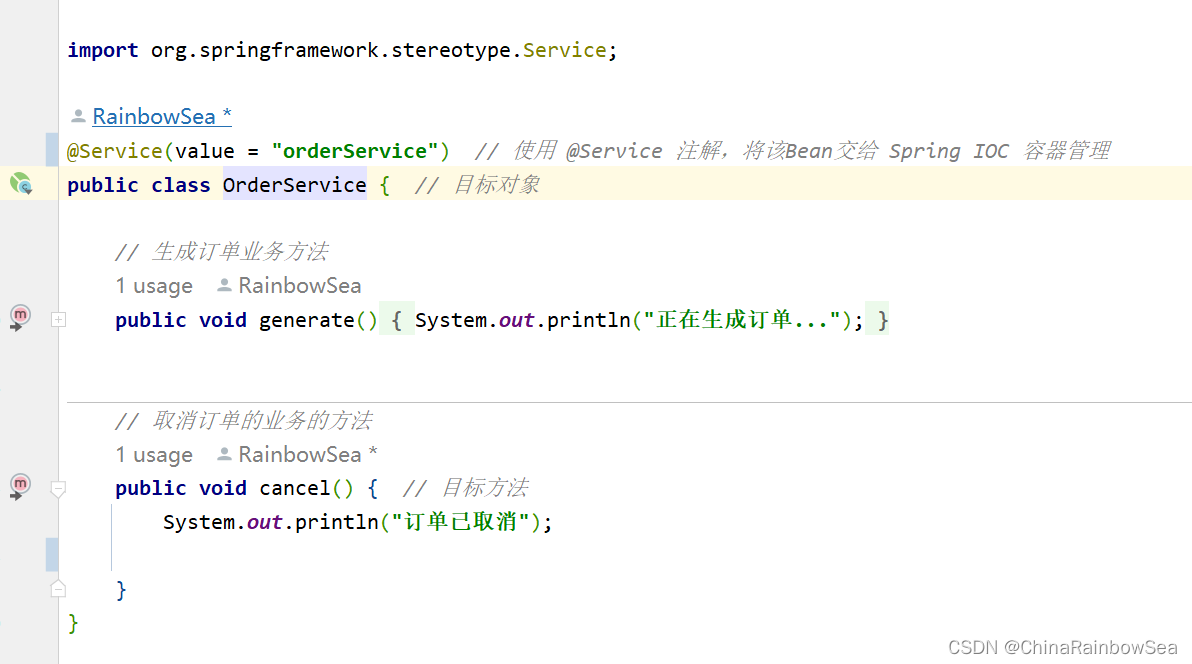
package com.rainbowsea.spring6.service;
import org.springframework.stereotype.Component;
import org.springframework.stereotype.Service;
@Component(value = "accountService")
public class AccountService { // 目标对象
// 转账的业务方法
public void transfer() { // 目标方法
System.out.println("银行账户正在完成转账操作...");
}
// 取帐的业务方法
public void withdraw() { // 目标方法
System.out.println("正在取款,请稍后...");
}
}
复制package com.rainbowsea.spring6.service;
import org.springframework.stereotype.Service;
@Service(value = "orderService") // 使用 @Service 注解,将该Bean交给 Spring IOC 容器管理
public class OrderService { // 目标对象
// 生成订单业务方法
public void generate() { // 目标方法
System.out.println("正在生成订单...");
}
// 取消订单的业务的方法
public void cancel() { // 目标方法
System.out.println("订单已取消");
}
}
复制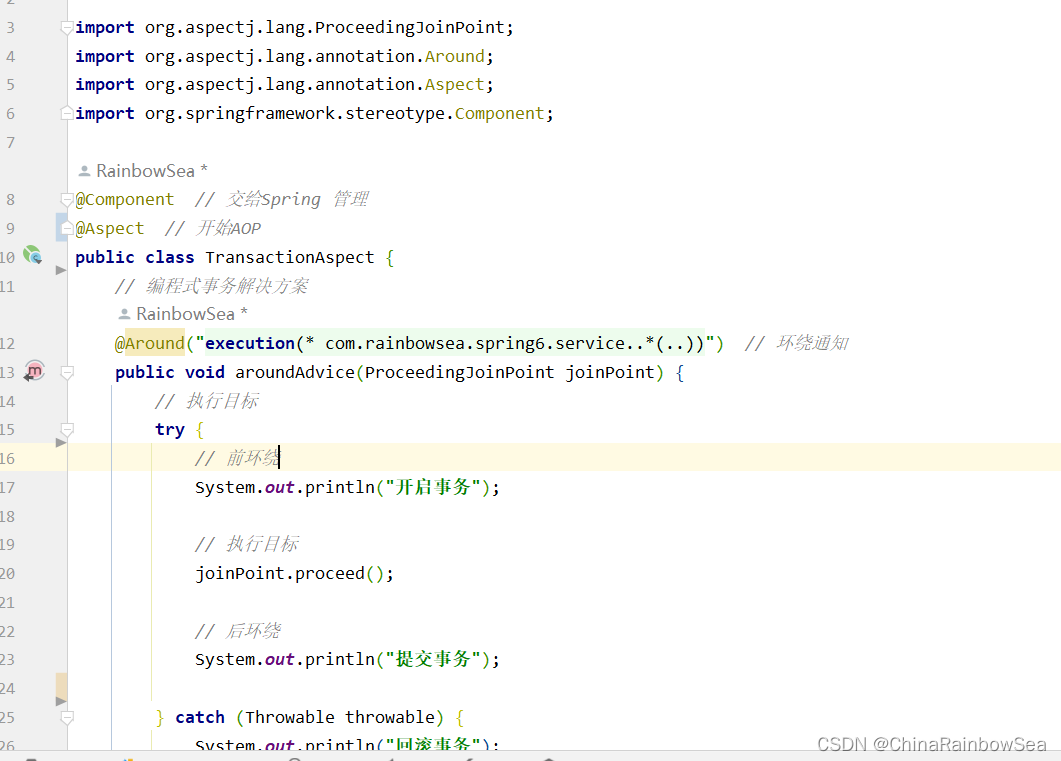
注意,以上两个业务类已经纳入spring bean的管理,因为都添加了@Component注解。
接下来我们给以上两个业务类的4个方法添加事务控制代码,使用AOP来完成:
package com.rainbowsea.spring6.service;
import org.aspectj.lang.ProceedingJoinPoint;
import org.aspectj.lang.annotation.Around;
import org.aspectj.lang.annotation.Aspect;
import org.springframework.stereotype.Component;
@Component // 交给Spring 管理
@Aspect // 开始AOP
public class TransactionAspect {
// 编程式事务解决方案
@Around("execution(* com.rainbowsea.spring6.service..*(..))") // 环绕通知
public void aroundAdvice(ProceedingJoinPoint joinPoint) {
// 执行目标
try {
// 前环绕
System.out.println("开启事务");
// 执行目标
joinPoint.proceed();
// 后环绕
System.out.println("提交事务");
} catch (Throwable throwable) {
System.out.println("回滚事务");
throwable.printStackTrace();
}
}
}
复制你看,这个事务控制代码是不是只需要写一次就行了,并且修改起来也没有成本。编写测试程序:
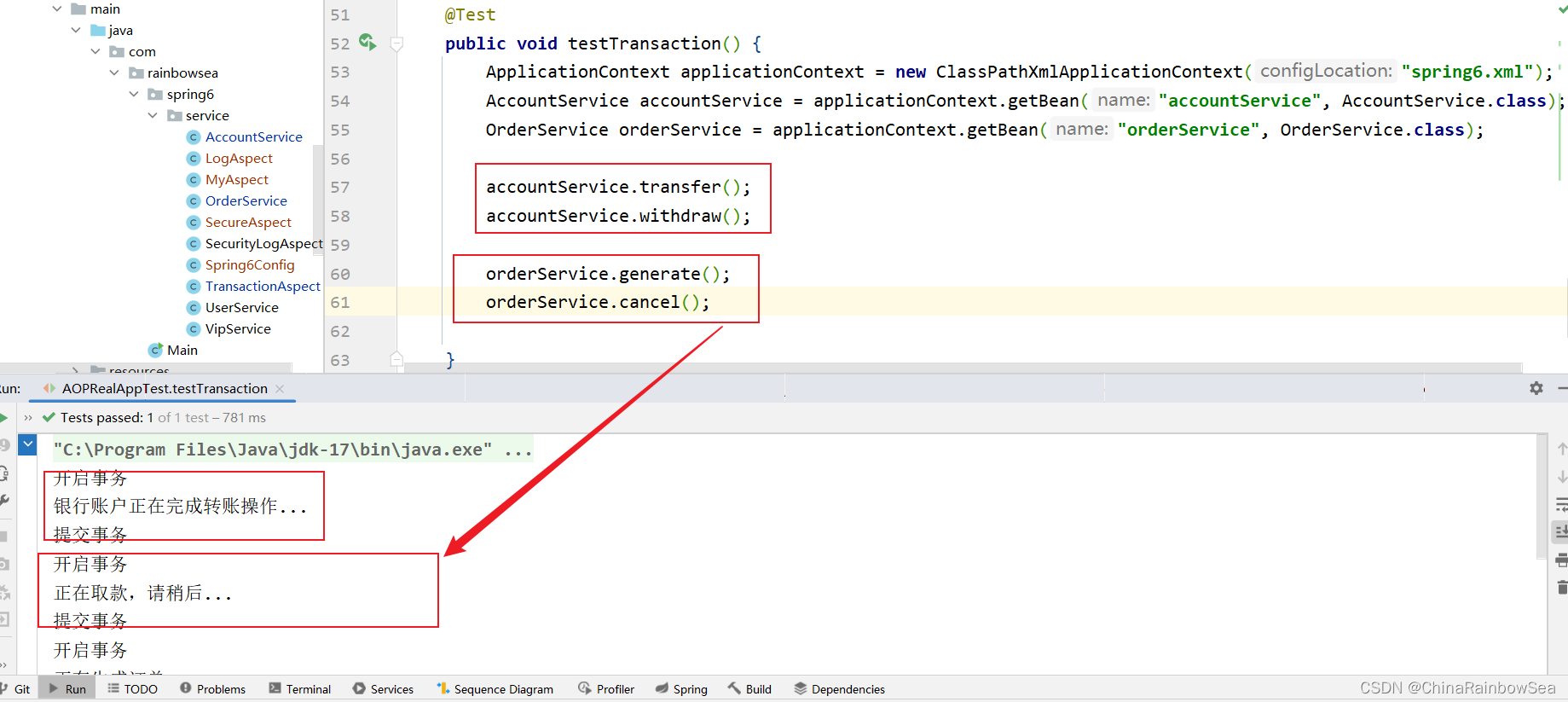
@Test
public void testTransaction() {
ApplicationContext applicationContext = new ClassPathXmlApplicationContext("spring6.xml");
AccountService accountService = applicationContext.getBean("accountService", AccountService.class);
OrderService orderService = applicationContext.getBean("orderService", OrderService.class);
accountService.transfer();
accountService.withdraw();
orderService.generate();
orderService.cancel();
}
复制通过测试可以看到,所有的业务方法都添加了事务控制的代码。
关于Spring 对事务的支持使用,由于涉及到的篇幅比较多,大家可以移步至:✏️✏️✏️ (链接)
需求是这样的:项目开发结束了,已经上线了。运行正常,客户提出了新的需求:凡事在系统中进行修改操作的,删除操作的,新增操作的,都要把这个人记录下来。因为这几个操作是属于危险行为。
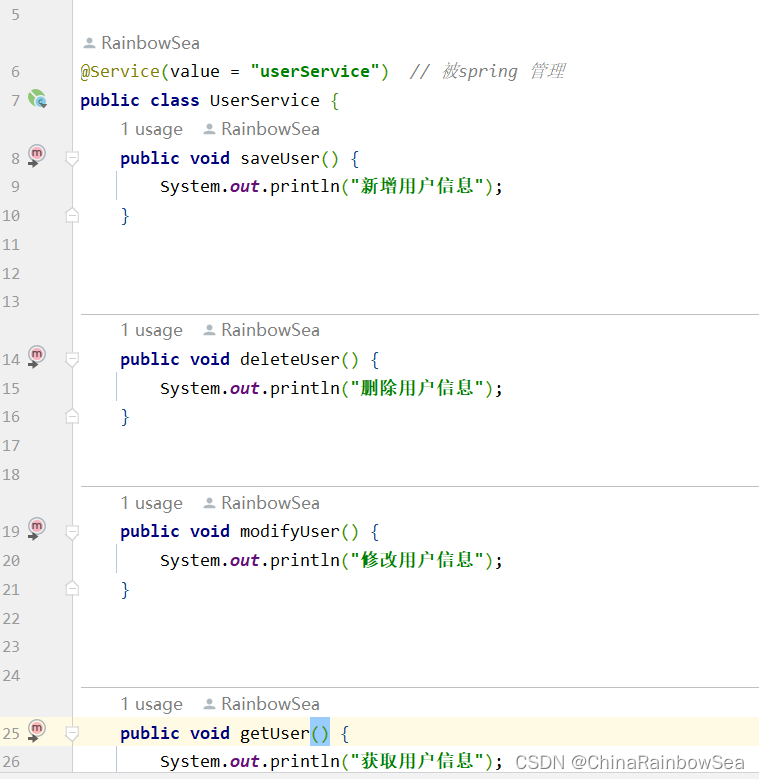
package com.rainbowsea.spring6.service;
import org.springframework.stereotype.Service;
@Service(value = "userService") // 被spring 管理
public class UserService {
public void saveUser() {
System.out.println("新增用户信息");
}
public void deleteUser() {
System.out.println("删除用户信息");
}
public void modifyUser() {
System.out.println("修改用户信息");
}
public void getUser() {
System.out.println("获取用户信息");
}
}
复制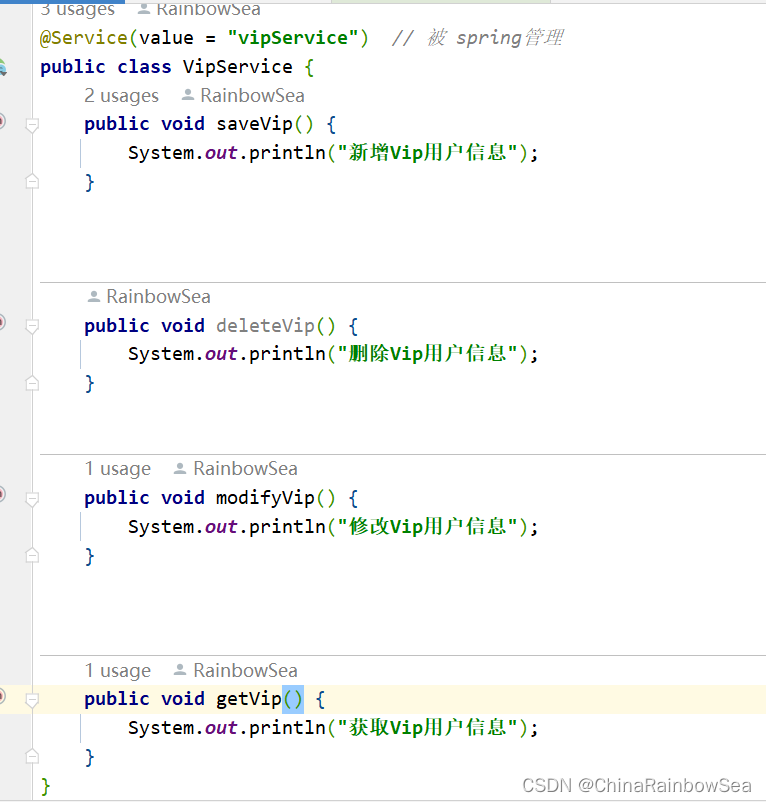
package com.rainbowsea.spring6.service;
import org.springframework.stereotype.Service;
@Service(value = "vipService") // 被 spring管理
public class VipService {
public void saveVip() {
System.out.println("新增Vip用户信息");
}
public void deleteVip() {
System.out.println("删除Vip用户信息");
}
public void modifyVip() {
System.out.println("修改Vip用户信息");
}
public void getVip() {
System.out.println("获取Vip用户信息");
}
}
复制注意:已经添加了@Component注解。
接下来我们使用aop来解决上面的需求:编写一个负责安全的切面类。
这里我们可以联合使用,多个类当中的不同的方法名对应 AOP事务进行也给控制
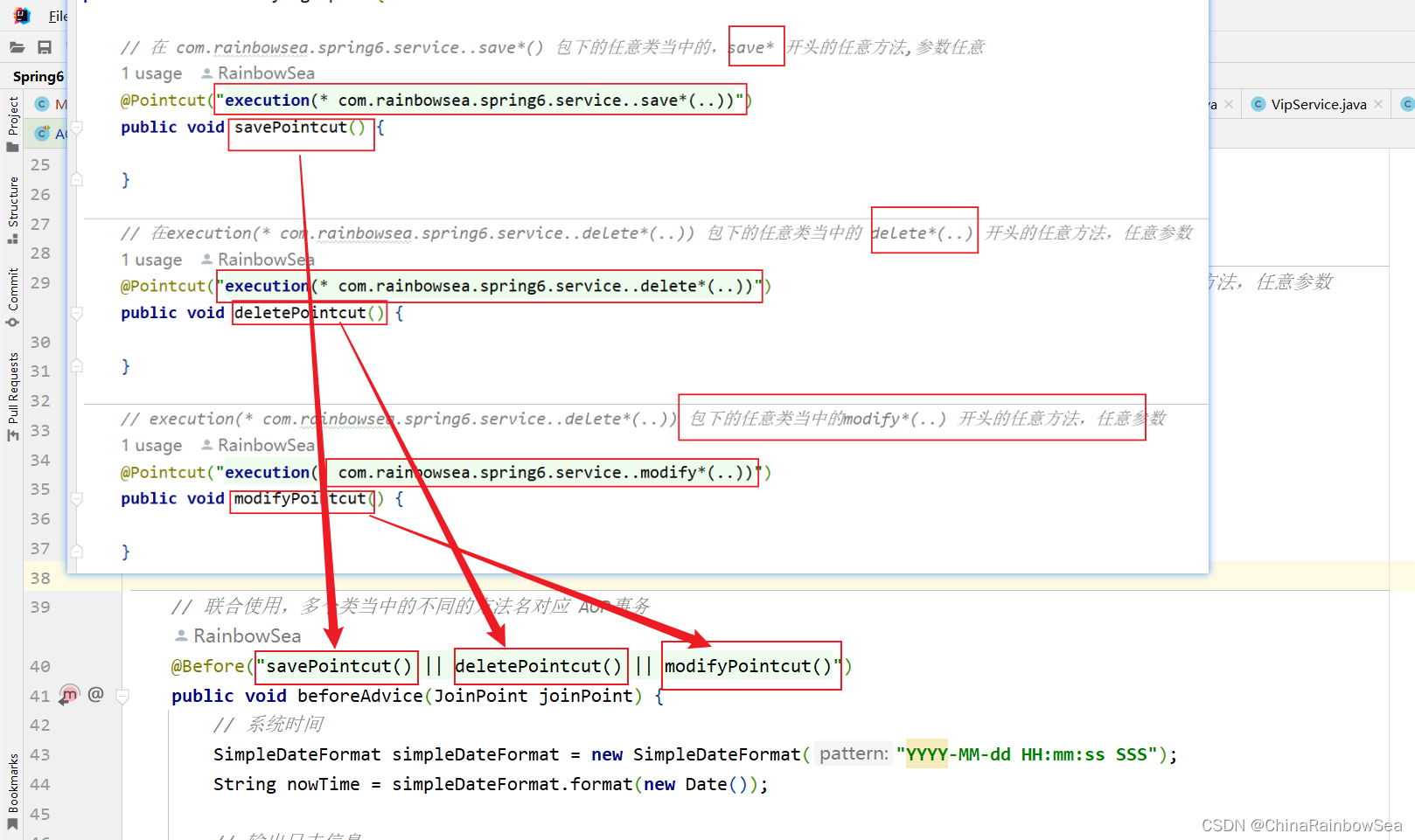
package com.rainbowsea.spring6.service;
import org.aspectj.lang.JoinPoint;
import org.aspectj.lang.annotation.Aspect;
import org.aspectj.lang.annotation.Before;
import org.aspectj.lang.annotation.Pointcut;
import org.springframework.stereotype.Component;
import java.text.SimpleDateFormat;
import java.util.Date;
@Component(value = "securityLogAspect") // 交给 spring 管理
@Aspect // 开启事务
public class SecurityLogAspect {
// 在 com.rainbowsea.spring6.service..save*() 包下的任意类当中的,save* 开头的任意方法,参数任意
@Pointcut("execution(* com.rainbowsea.spring6.service..save*(..))")
public void savePointcut() {
}
// 在execution(* com.rainbowsea.spring6.service..delete*(..)) 包下的任意类当中的 delete*(..) 开头的任意方法,任意参数
@Pointcut("execution(* com.rainbowsea.spring6.service..delete*(..))")
public void deletePointcut() {
}
// execution(* com.rainbowsea.spring6.service..delete*(..)) 包下的任意类当中的modify*(..) 开头的任意方法,任意参数
@Pointcut("execution(* com.rainbowsea.spring6.service..modify*(..))")
public void modifyPointcut() {
}
// 联合使用,多个类当中的不同的方法名对应 AOP事务
@Before("savePointcut() || deletePointcut() || modifyPointcut()")
public void beforeAdvice(JoinPoint joinPoint) {
// 系统时间
SimpleDateFormat simpleDateFormat = new SimpleDateFormat("YYYY-MM-dd HH:mm:ss SSS");
String nowTime = simpleDateFormat.format(new Date());
// 输出日志信息
System.out.println(nowTime + "zhangsan" + joinPoint.getSignature().getDeclaringTypeName()+
"." + joinPoint.getSignature().getName());
}
}
复制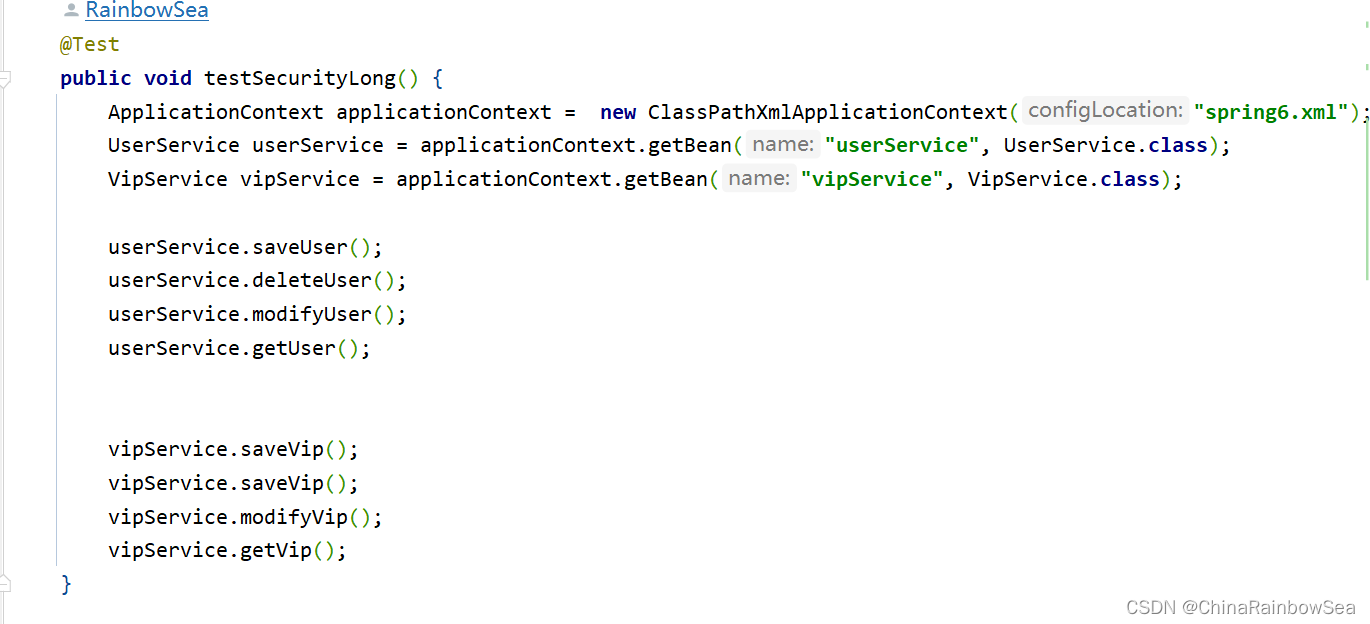
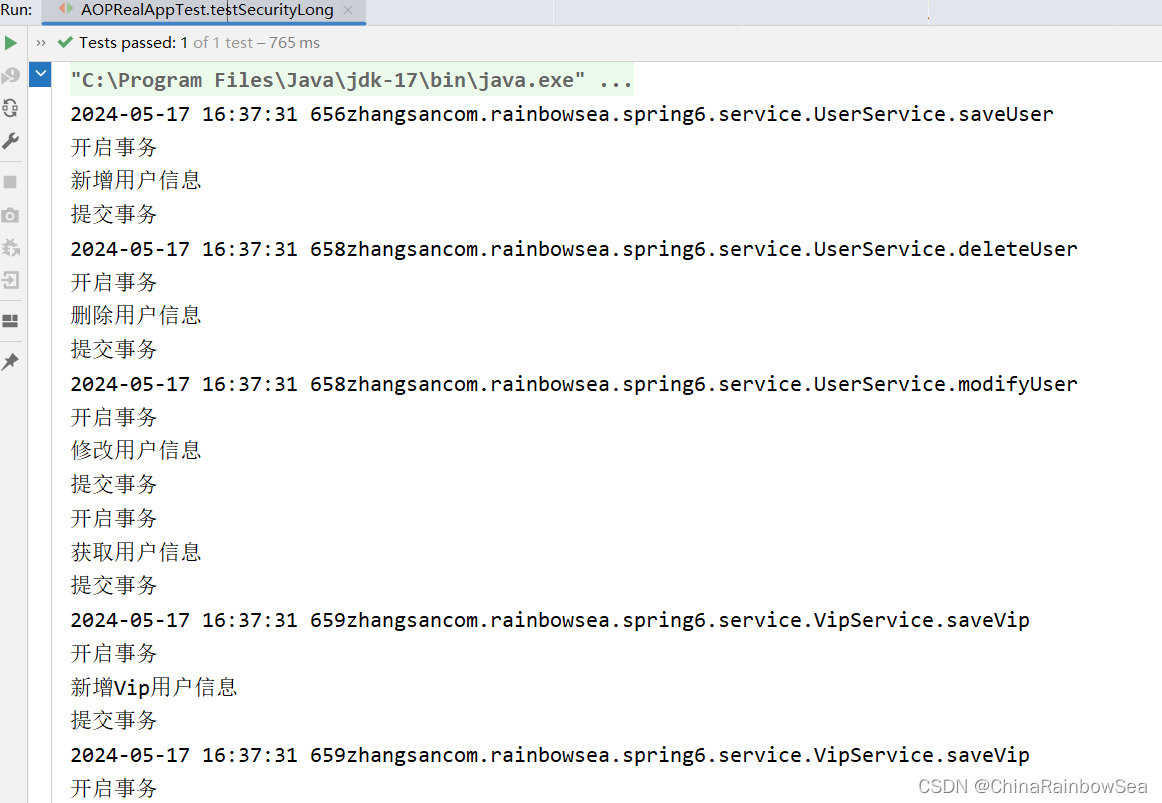
@Test
public void testSecurityLong() {
ApplicationContext applicationContext = new ClassPathXmlApplicationContext("spring6.xml");
UserService userService = applicationContext.getBean("userService", UserService.class);
VipService vipService = applicationContext.getBean("vipService", VipService.class);
userService.saveUser();
userService.deleteUser();
userService.modifyUser();
userService.getUser();
vipService.saveVip();
vipService.saveVip();
vipService.modifyVip();
vipService.getVip();
}
复制
- 简单的说AOP:就是将与核心业务 无关的代码抽离开来,形成一个独立的组件,然后,以横向 交叉的方式应用到业务流程当中的过程被称为 AOP
- AOP的七大术语
- AOP 的五种通知(通知叫增强,就是具体你要插入\添加 的代码。)的特点:及其对应的注解
- AOP的切点表达式,所谓的切点表达式:就是用来定义通知(Advice) 往哪些方法上切入的。
execution([访问控制权限修饰符] 返回值类型 [全限定类名]方法名(形式参数列表) [异常])复制
- 切面类也是要纳入Spirng IOC 容器当中管理的,因为你是在Spring 框架当中运用的AOP 编程,当然,需要被Spring 管理到,Spring 管理不到,又该让它如何使用呢。
- 所有的五种通知上的使用都必须在该对应的类上,要在该切面类上添加上
@Aspect开启事务的注解才行。同时也要纳入Spirng IOC 容器当中管理的。才行- 五种通知,可以配合上,同时使用上时
- 环绕通知是范围最大的(也是是说,环绕通知的(前环绕)是在所有通知的最前面执行的,而环绕通知的(后环绕)是在所有通知的最后面执行的)。
- 存在异常时,异常通知执行了,但是后面的:后置通知,环绕通知的(后环绕)通知,并不会执行,被异常给中断了。
- 切面的先后顺序的设置:关于这一点:我们可以使用
@Order注解来标识切面类,为@Order注解的 value 指定一个整数型的数字,数字越小,优先级越高。- 切点表达式的优化:我们可以使用:
@Pointcut注解来定义独立的切点表达式。
注意这个 @Pointcut 注解标注的方法随意,只是起到一个能够让@Pointcut注解编写的位置。- 第一种方式:Spring 框架结合 AspectJ框架实现的AOP,基于注解方式(该比较常用)。
- 第二种方式:Spring框架结合AspectJ框架实现的AOP,基于XML方式。
- 关于Spring 在事务上的支持上的使用,由于涉及的篇幅内容过多,所以就不在这里说明了,想要了解更多的可以移步至:✏️✏️✏️
切面类要不仅要加上 开始事务的注解,也要添加上 Spring IOC 容器管理的注解。
“在这个最后的篇章中,我要表达我对每一位读者的感激之情。你们的关注和回复是我创作的动力源泉,我从你们身上吸取了无尽的灵感与勇气。我会将你们的鼓励留在心底,继续在其他的领域奋斗。感谢你们,我们总会在某个时刻再次相遇。”
本文详细探讨了Spring框架中的面向切面编程(AOP),特别是通过@EnableAspectJAutoProxy注解来启用和配置AOP的详细过程。